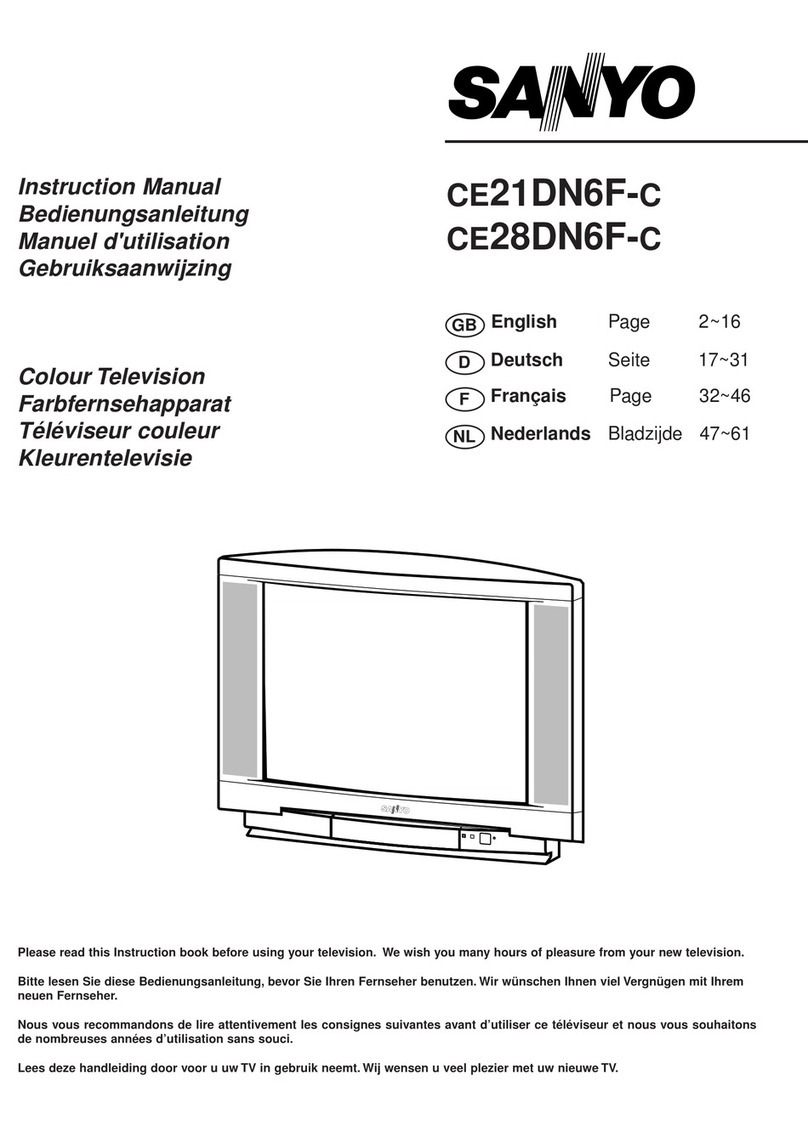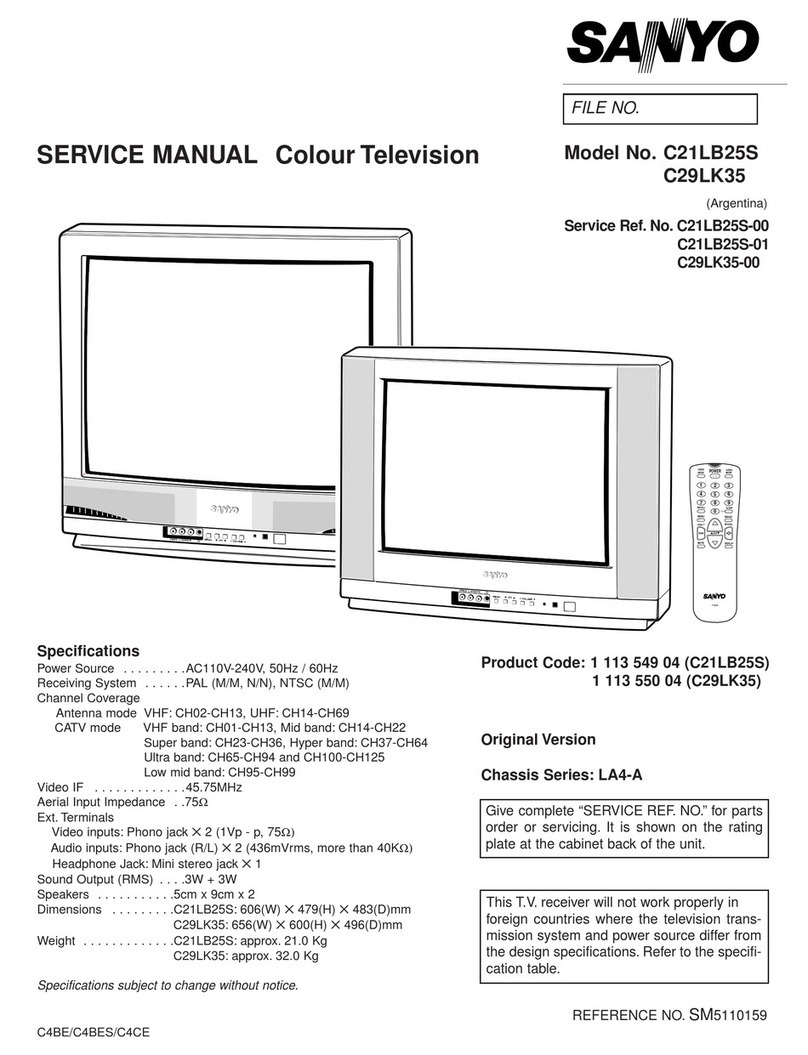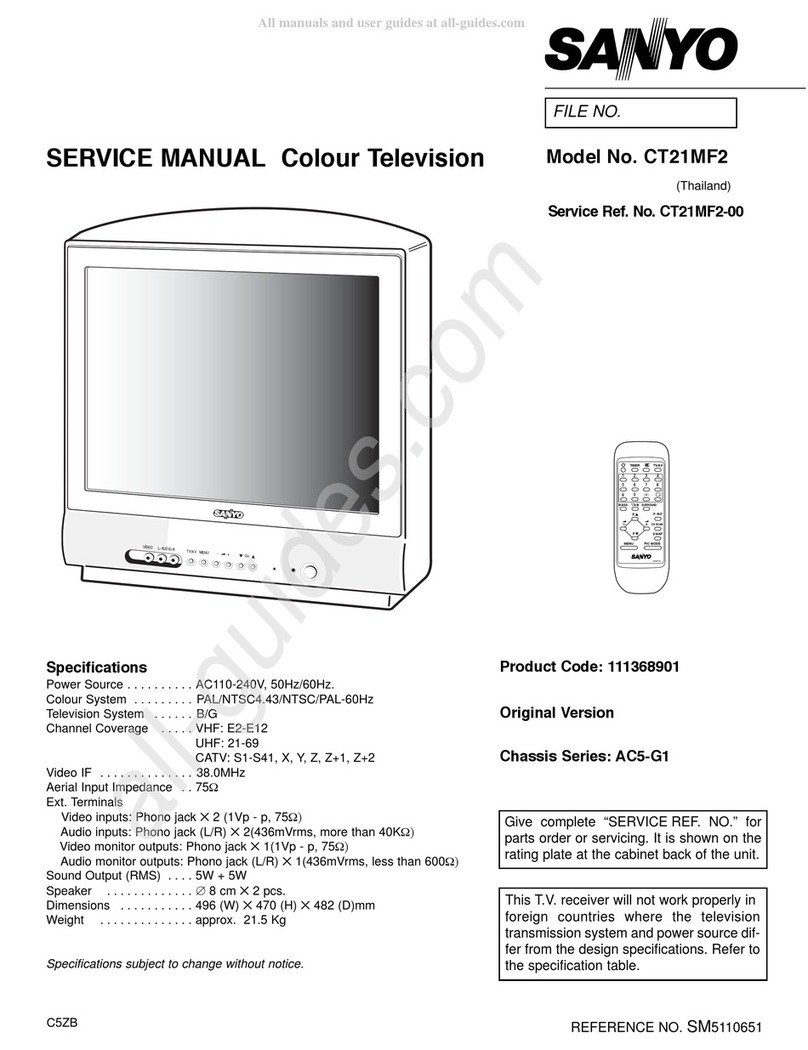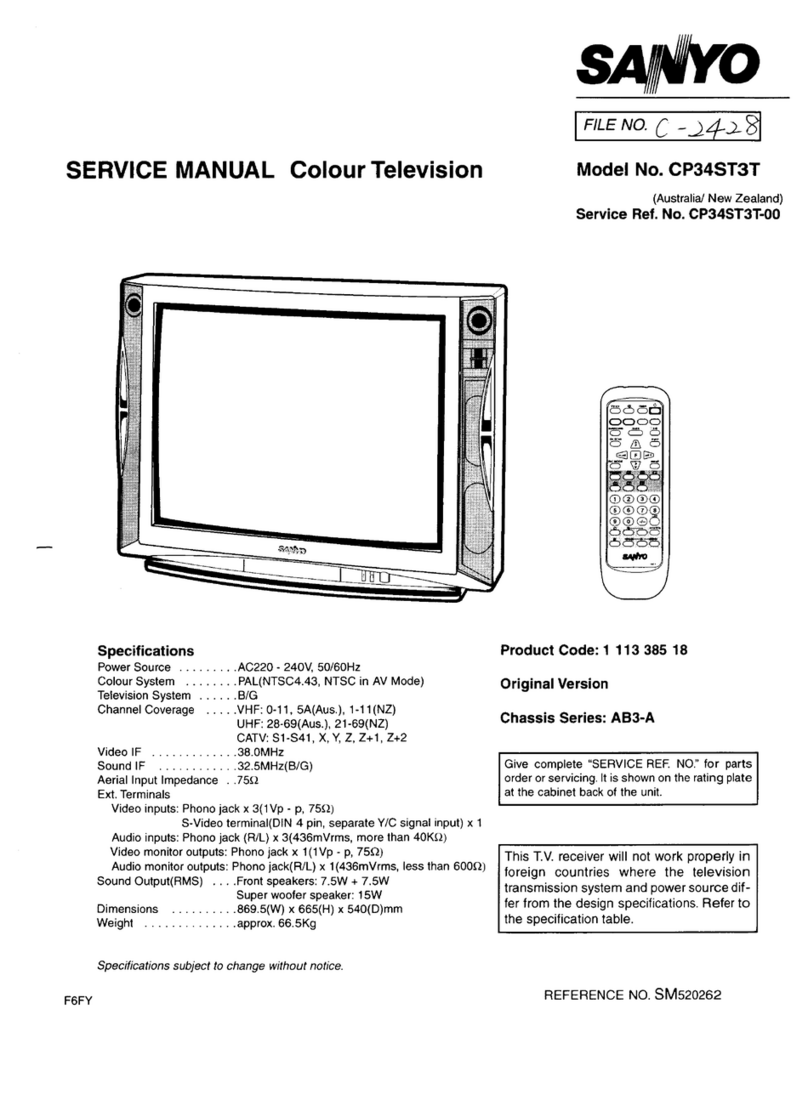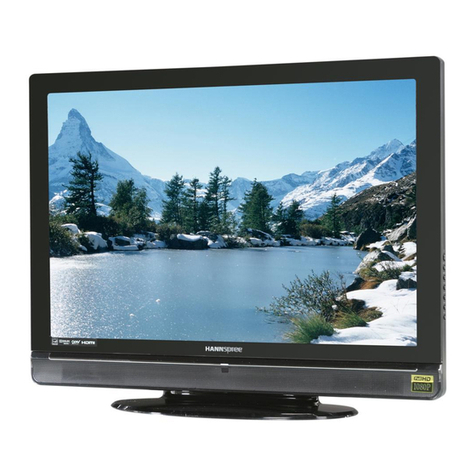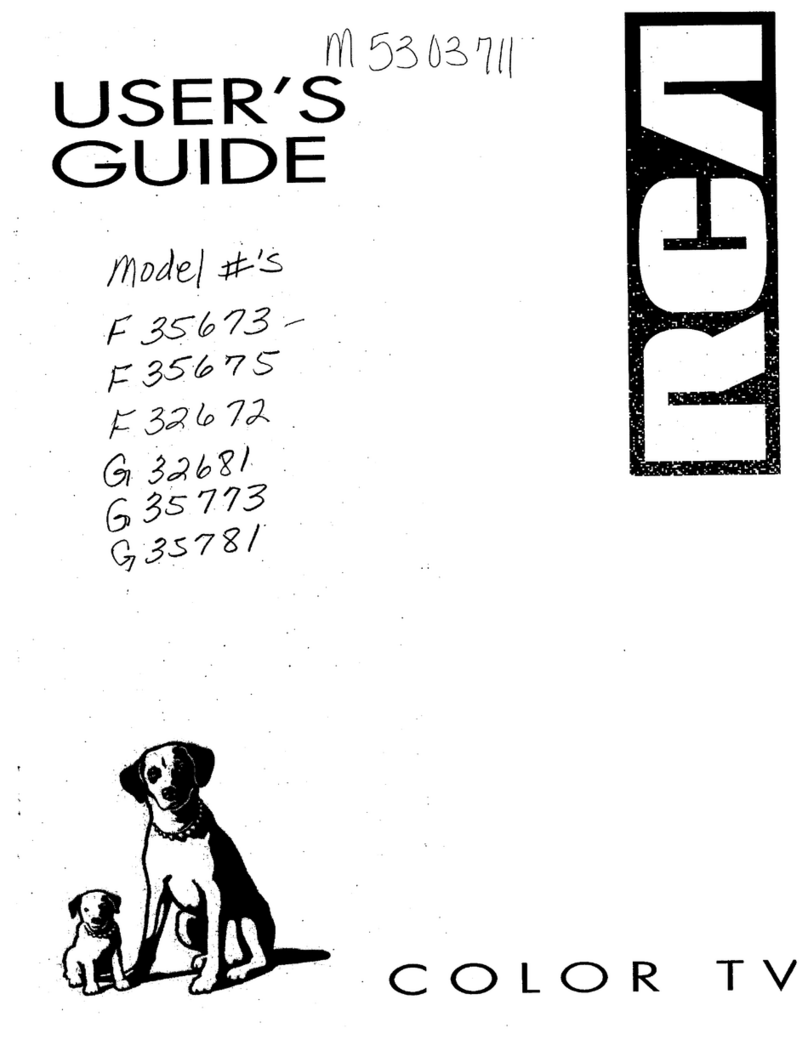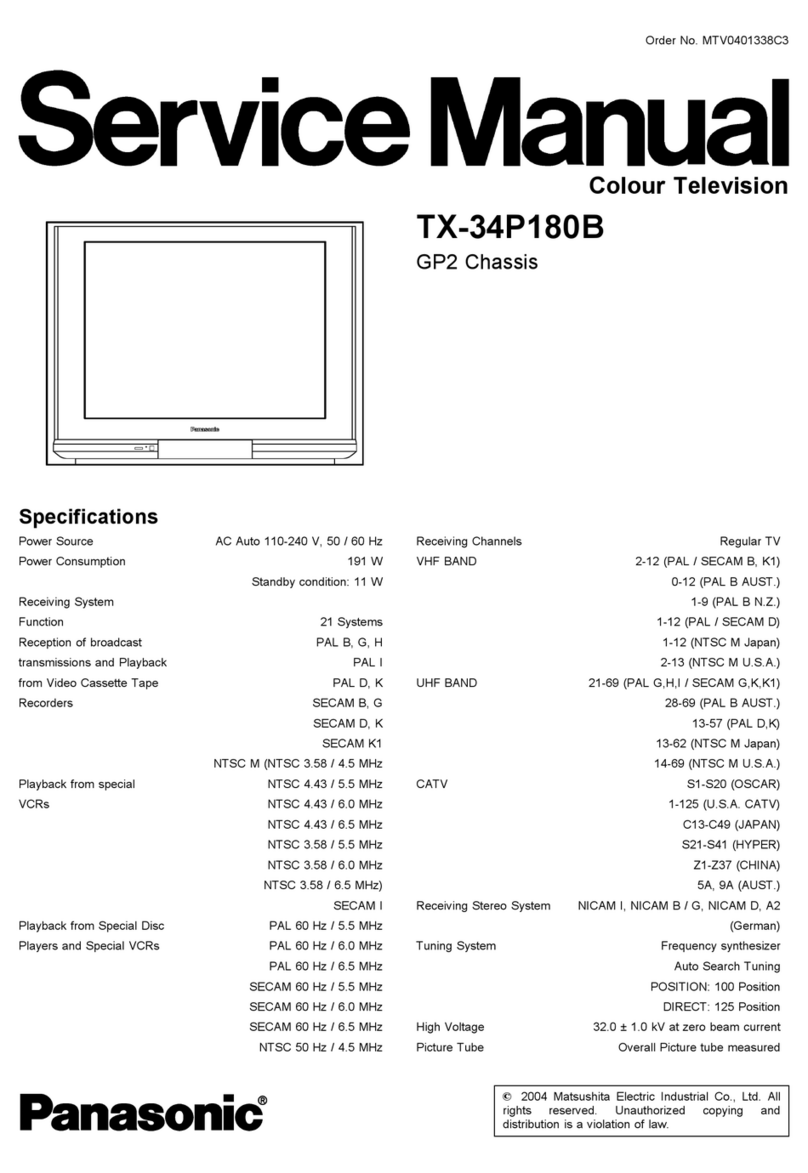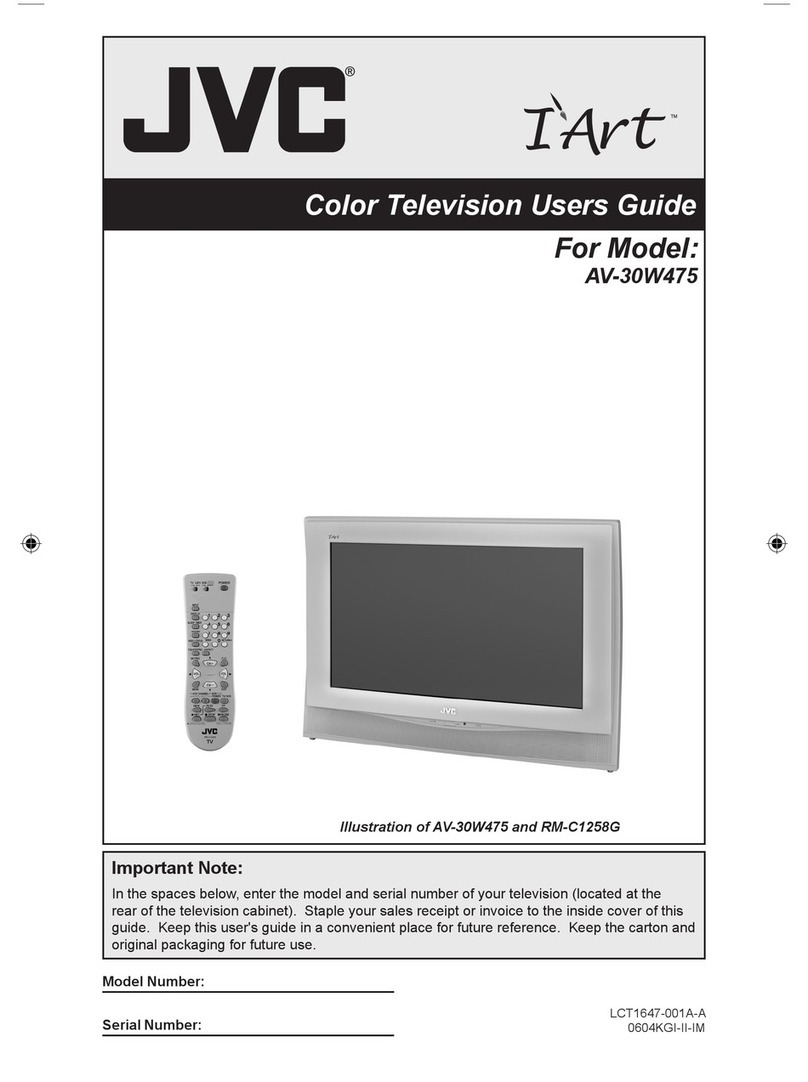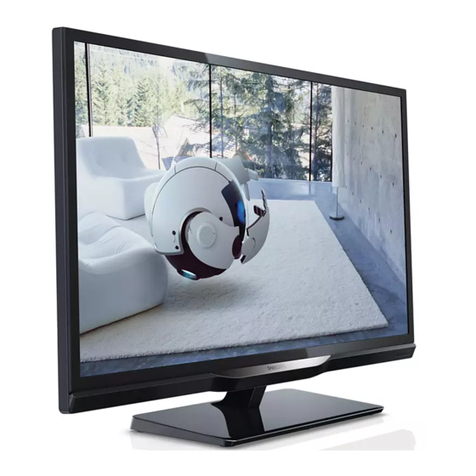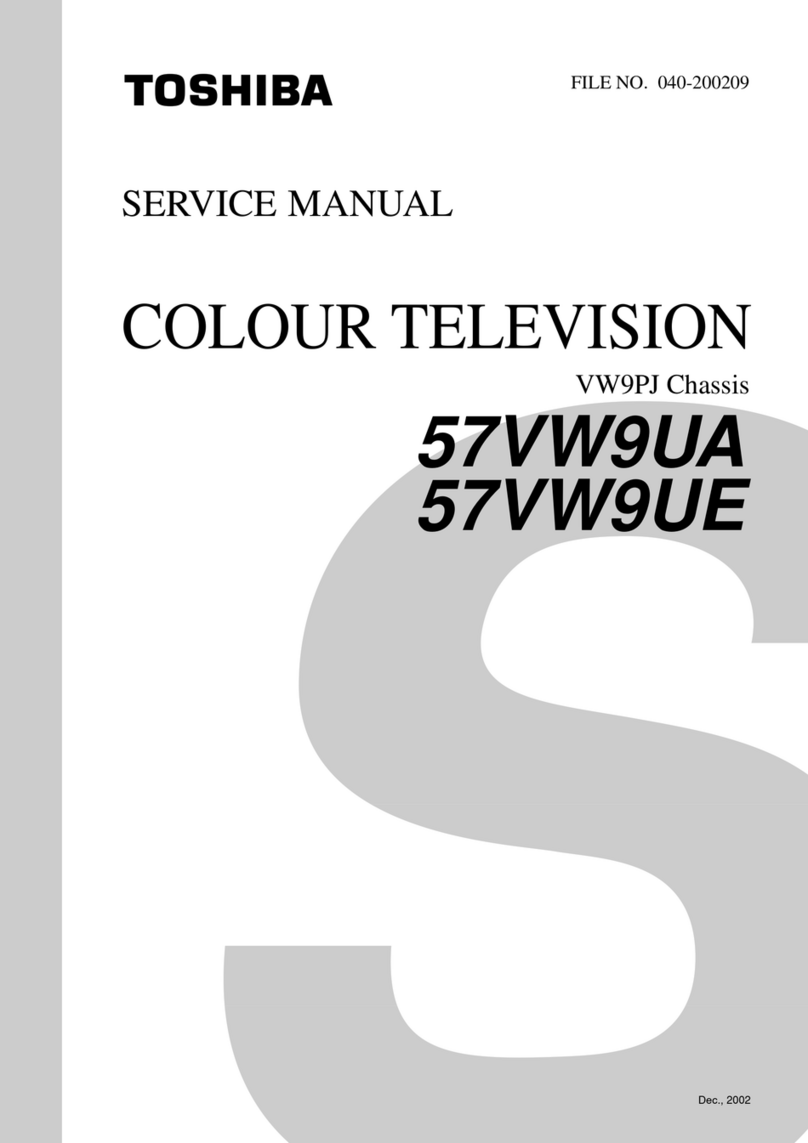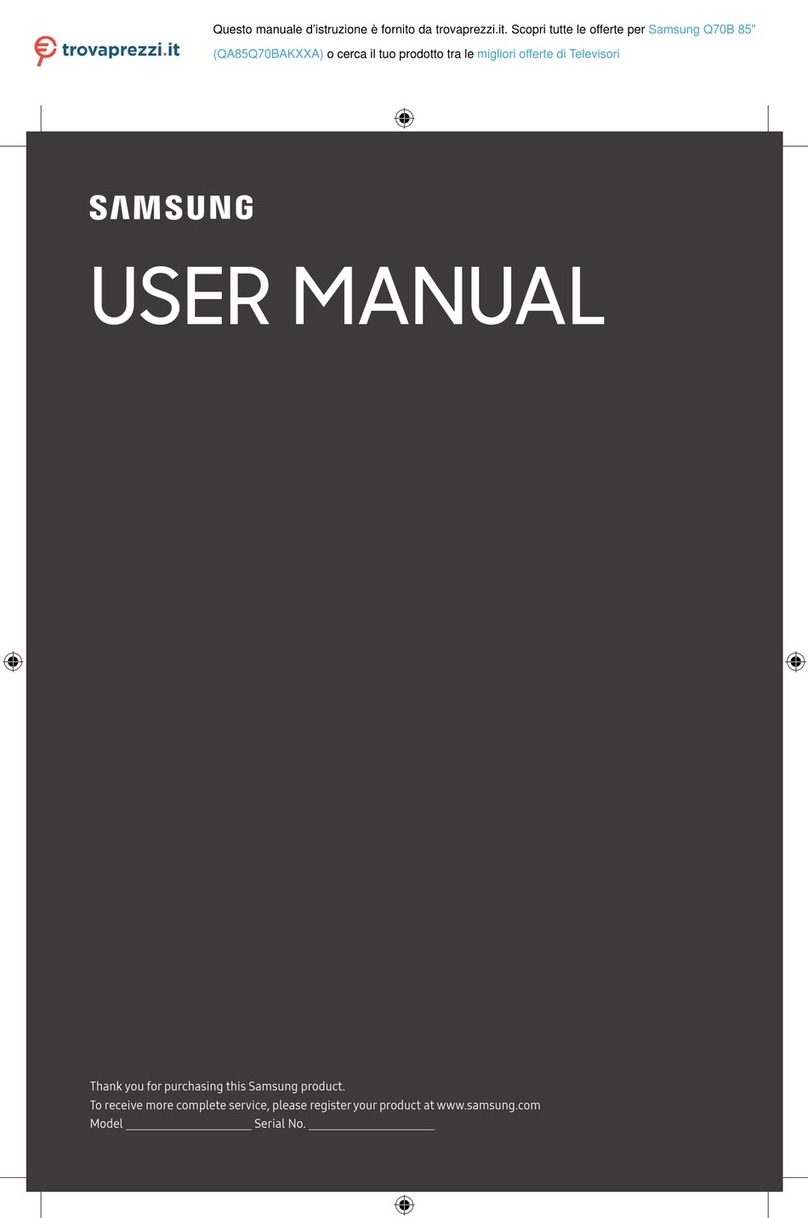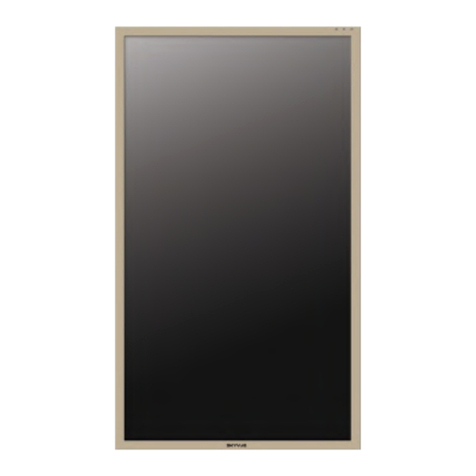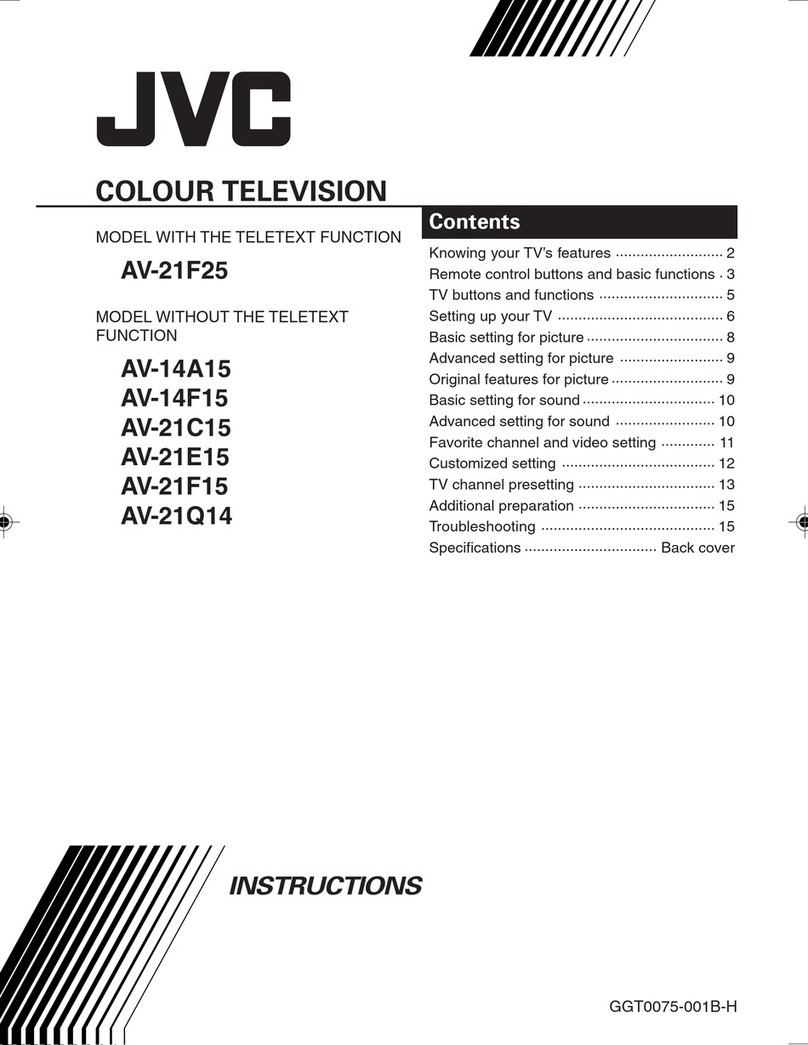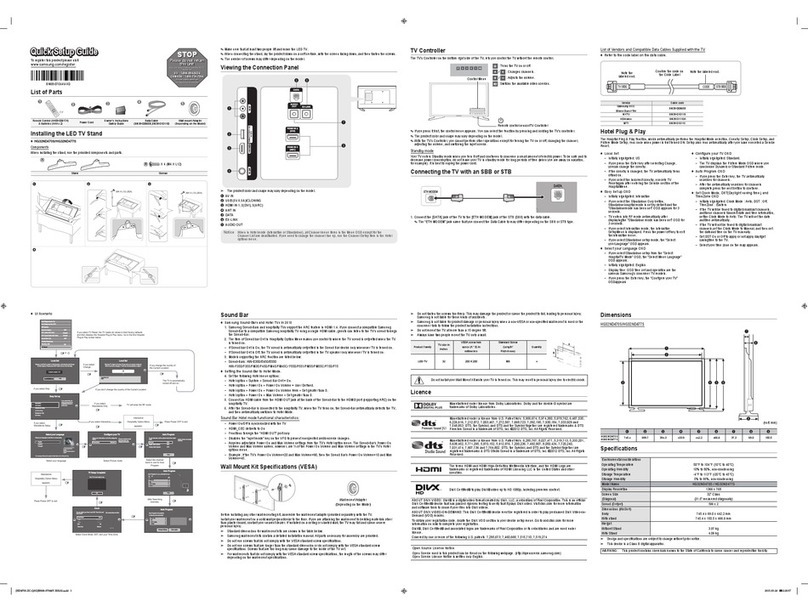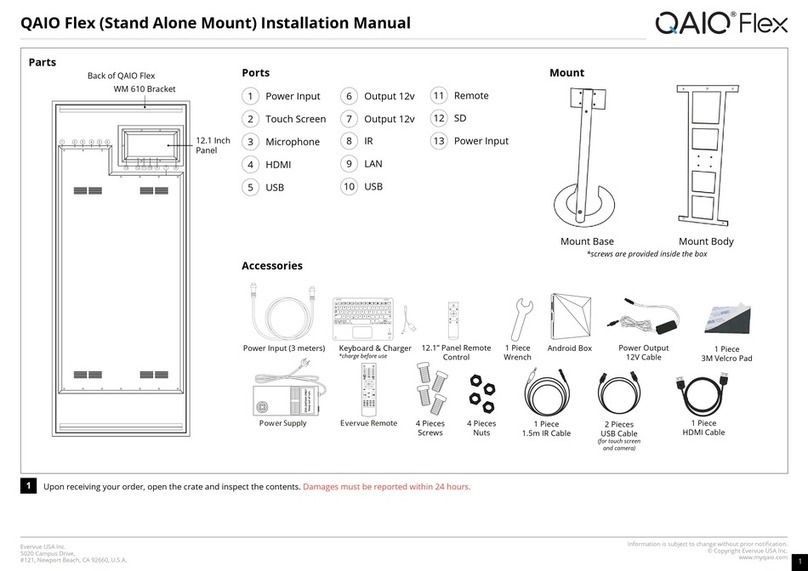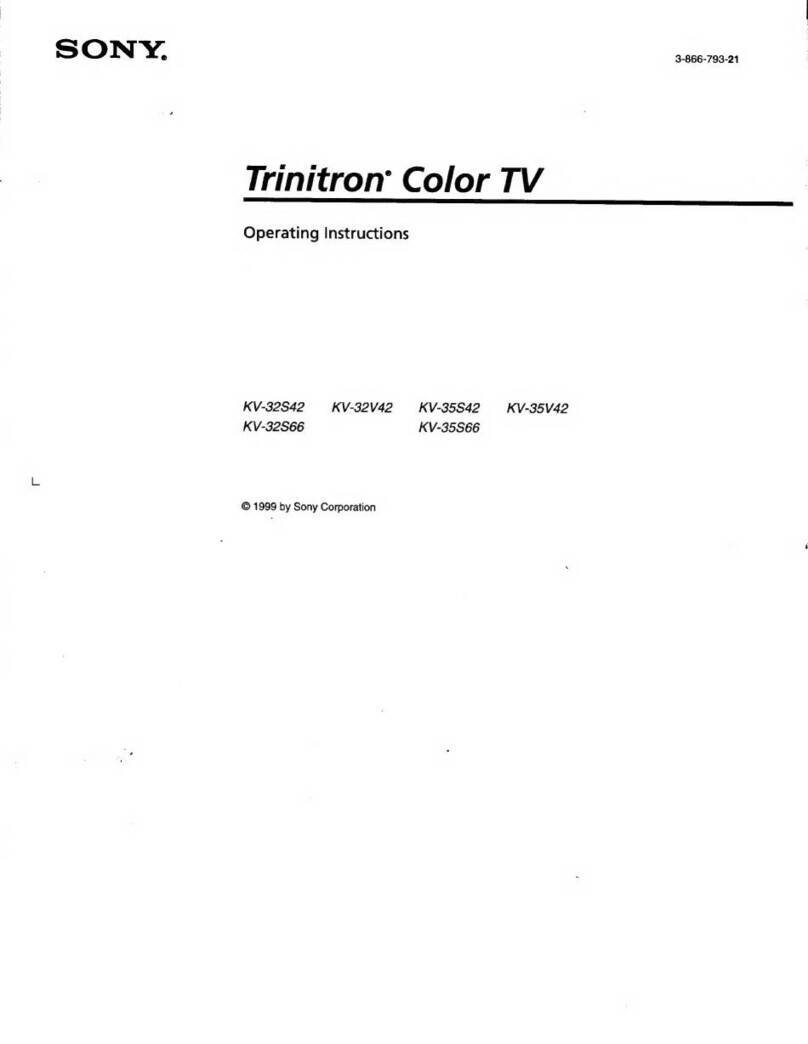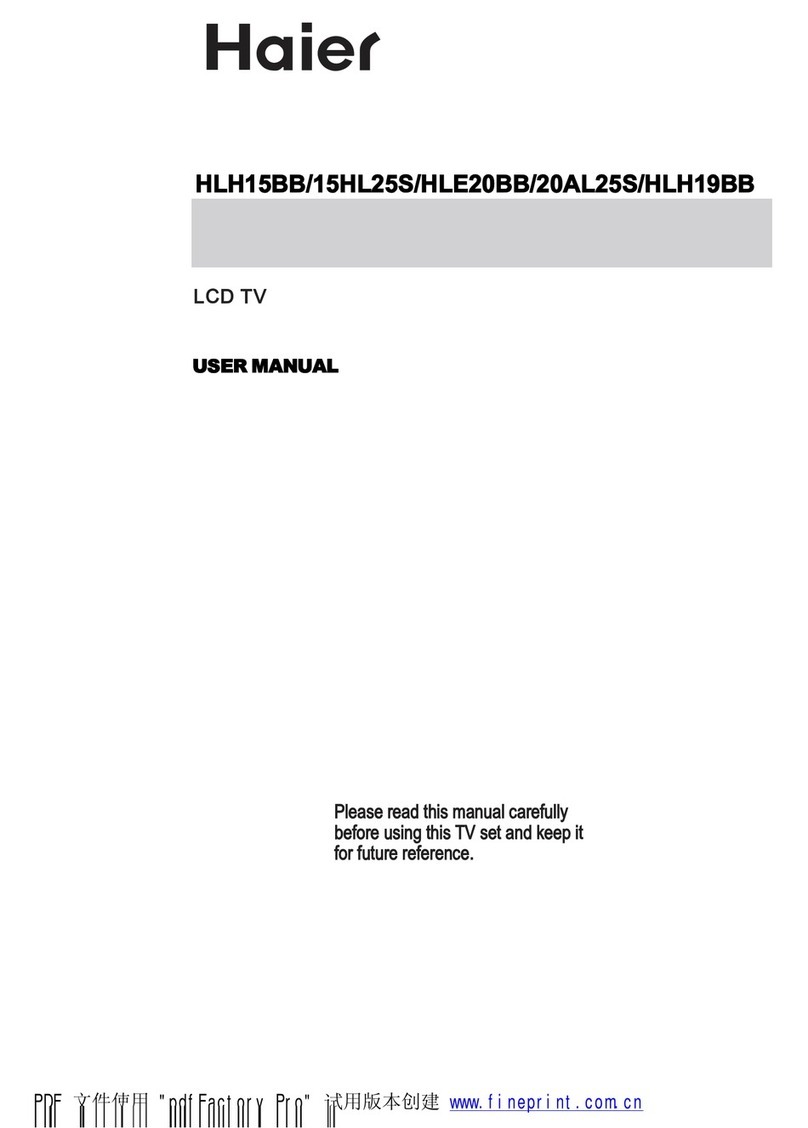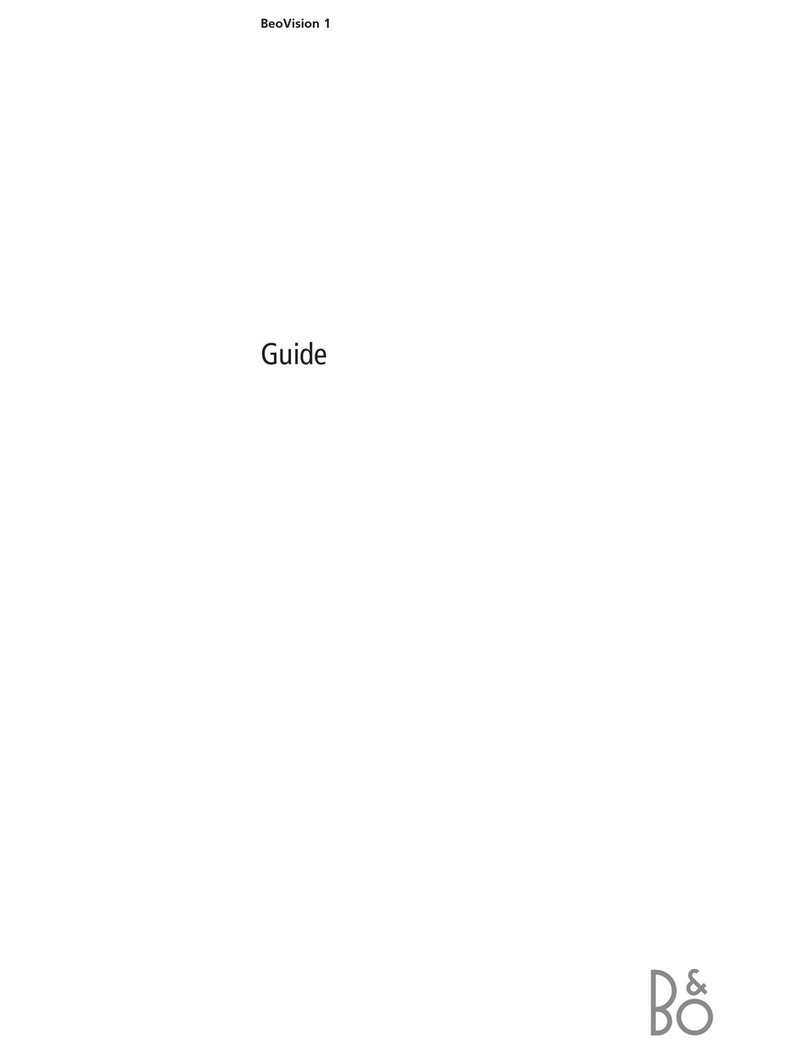Sanyo CZP2510 User manual

Instruction
Manual
STEREO (NICAM)
SURROUND
TELETEXT*
STERMINAL
Colour
Television Model CZP2510
CZP2510TX
CZP2910
CZP2910TX
.
“Model CZP2510/CZP2910 –Not equipped with the Teletext Decoder.
Optional Teletext Decoder Type No. TX-231.

Introduction
■Hi-Fi Stereo Sound Circuit with Sur-
round Circuit.
It’s easy to enjoy TV and video sound with the Surround
ef feet.
SurroundSystem
The sounds that we hear in anatural listening
environment consist of those which reach
our ears directly from the sound source, and
those which reach us indirectly after being
reflected off of the floor, walls. and other sur-
rounding objects. The Surround System elec-
trically produces these direct and redirect
sounds, then sends them through speakers to
surround the listener with sound that isrich in
stereo presence.
Where to Place the TV for the best Surround Effect
.Do not place furniture or other objects any closer than 30 cm
from the sides of the TV. Placing objects directly next to the
sides of the TV will block the sound from the speakers.
●lt is agood idea to place the TV in acorner of the room. This
allows the walls to serve as reflectors to achieve agreater
Surround effect.
HThis AV Television Allows Free System
Expansion
●S-terminal is provided.
●CENELEC standard 21-pin terminals is provided.
●Two videolaudio inputs and one audio output enable easy
VTR connection for tape playback and editing.
■Choose From Two Viewing Angles
(Model CZP2910/CZP2910TX only)
Place the TV _Approx. 1.5° Or extend the
as it is for a.rear adjustors
1.5° slant. to make the =~T’
screen
4Jp
perpendicular. !
Using the To extend Tocontract
‘d’ust”rs %!!?7!%%!9’ G“’and
Becareful not to over-adjust and cause the TV to tip over forward
Electric Mains
The TV receiver is manufactured to utilize an AC VOLTAGE
SOURCE of 230 Volts, 50 Hz.
Range of operation: 170V (min.) –280V (max.)
SafeW Precaution
When the TV receiver is not to be used for an extended period
of time, it is advisable to disconnect the AC power cord from
the AC outlet.
WARNING
To prevent fire or shock hazard, do not expose the unit to rain
or moisture.
High voltages are used in the operation of this TV set.
Do not remove the back from your set. Refer servicing to quali-
fied service personnel.
Aerial Connection
●Connect the cable with aplug from aUHF (or VHF) aerial to
the lr aerial socket on the cabinet back.
———
———.
———.
————
———
_—— =
lr aerial socket
●For all aerial circuit problems please consult your local dealer.
–l–

I
...
‘.
Controls
Opening the Control
Door
Press the triangular mark to
open.
I
k? Yml-u o
d
BDMO
uJ
@Headphone JackJ Memory
VIDEO Input Jack (AVl)~ Volume @BAND
AUDIO (L) Input Jack (AVl)- e~Tuning
AUDIO (R) Input Jack (AV1) ~J&PICTURE SELECT
Ii
b:
SOUND SELECT PRESET
Dubbing Switch @TV/VIDEO Selector Programme Selector
I
Operation of the Receiver
Switching on/off
●To turn on the TV:
Press Mains ON/OFF switch ~.
●To turn off the TV:
Press the Power ON/OFF button ~on the remote control
transmitter, and the TV changes to the standby mode. During
the standby mode, the standby and power indicator illumi-
nates more brightly than during the power–ON mode.
Press this button ~to turn off the unit for short periods
of the time.
●To turn on the TV from the standby mode:
Press one of these button.
1
Power ON/OFF ~
(Remote control transmitter)
Programme Selector ~
(Remote control transmitter)
Volume @
.To cut off the mains power completely:”
Press the Mains ON/OFF switch ~.
Important! Be sure to set the Mains ON/OFF switch ~to the
off position, if the power failure occurs while view-
ing.
–2–
●AUTO SHUT OFF
This TV set incorporates the AUTO SHUT OFF function.
Even if the TV is left on after you have gone to sleep, the
TV set changes to the standby mode within 10 minutes
after all broadcasts have ended.
Note: AUTO SHUT OFF also functions for the AV mode even
when there is no signal being transmitted.
The remaining time for AUTO SHUT OFF is displayed on
the screen.
n
‘emainingtime
Programme selection
Press the right side (+) of the programme selector ~of the
TV set, and the TV set will step up to the next station, i.e; 1,2,
3...29, VCR1, VCR2, VCR3, 1,2,3 ...
Press the left side (–), and the TV set will step down to the
previous station.
.>
-.,,

(Operation of the Receiver)
Sound adjustments
●To adjust the sound volume:
Press +or –volume obutton.
E
-SOUNO
mmm91n IBM-------
.To adjust the bass, treble, balance and the depth of surround
effect:
Select the control function by pressing SOUND SELECT@
button.
@.... TV/VIDEO Selector
To watch the television programmed leave this switch in the
TV mode. When this switch is set to the VIDEO mode you can
enjoy the playback from the VCR or other AV equipment con-
nected to the AV input terminals.
Each time the TV/VIDEO Selector @is pressed, the AV posi-
tion changes as follows:
,a-a
TV mode_
●Each time SOUND SELECT@ button is pressed, the con- ‘In the AV mode, you can select the TV programme.
trol function changes as follows:
‘): BASS
--..-.-- +---- l---
BAss
t
“k+zl.ll”k
TREBLE BALANCE
1
k.!T!2J15i!!!9
SOUND VOLUME SURROUND
LEVEL
Note: “SURROUND LEVEL” will be skipped when the Sur-
round effect is turned off.
Adjust the bass, treble, balance or the depth of surround ef-
fect by pressing Volume @button.
Picture adjustments
❑Select the picture control function by pressing PICTURE
SELECT @button.
●Each time PICTURE SELECT @button is pressed, the
control function changes as follows:
L__._J4
~COLOUR
m#llalnlt -------
COLOUR
t
I1-
I-IiEE4
BRIGHTNESS II
CONTRAST
II I Iv.TON
<> . . . . . . . . +--, ----- 1
/
——
FINE TUNING VIDEO TONE
❑Adjust the colour intensity, brightness, contrast video tone
or fine tuning by pressing Volume @button.
–3–
●For example, to select the programme position “7” in the AV
mode (while watching the play backing from aVTR):
~Press “7” button of
programme selector ~.
❑Press TV/VIDEO Selector
and the picture of
programme position “7”
appear.
~.... Memory O
the
L
au 2
7
Programme
number
Gi
the
will 17
This function lets you store the settings (for colour, bright-
ness, contrast, video tone, sound volume, bass, treble,
balance and Surround effect) in memory for both picture and
the sound. Simply adjust the picture and sound as desired,
then press’ the Memory O@button. To recall these levels.
from memory, press the Normalization ~0~ @button c
the remote control unit.
D
When Memory button
is pressed, “NORMAL’
is displayed.
NORMAL
-. -++---
~.... Headphone Jack ~
Insert the headphones plug into this jack to listen to either
stereo or monaural sound via aheadphones set.
Note: No sound will be heard from the speakers when the
headphones plug is connected to this jack.
,. .’, ,,. .
,..
... . .
,,,
.

Remote Control Operation
r
~Programme Selector
1
@Surround ON/OFF
@Normalization ~
Colour ~
erightne~~~
co.tr~.t~
@Stereo/Mono ~
~poweroN/oFF
@Off timer
@TV/VIDEO Selector
—~ Channel Scanning
@Recall
-Sound mute
Svolume Fine tuning
~AUDIO SELECT
\@Bilingual A/B
Main ON/OFF switch of the TV set must be in “ON” position Picture adjustments
before remote control operation is possible.
Point transmitter towards the TV set, then press the appropri- .To adjust the colour intensity:
ate function button for the following controls. Press @(Colour) button.
~Power ON/OFF u$
Press Aor ~volume ~button.
!--!
@COLOUR
Press this button to switch TV set on. DnnlaIm91-------
To switch TV set off, press again.
.&) .... Programme selection
●e.g. To select programme number 17, press “1-“ button and .To adjust the brightness:
then press “7” button ~within five seconds. Press @(Brightness) button.
To select programme number 27, press “2-” button and +
then press “7” button ~within five seconds. Press Aor ~volume button.
■You can select any desired programme number directly
from standby mode.
●e.g. To directly select programme number 2from stand-
by mode, press the “2” button. The set is then
switched on, and the picture of programme number
2appears.
To directly select programme number 16 from stand-
by mode, press the “l-” button (after which the
Standby and Power indicator flashes), then press the
“6” button. The set is then switched on, and the pic-
ttire of programme number 16 appears.
.To adjust the picture contrast:
Press ~(Contrast) button. I I
+
Press Aor ~volume button.
M
–4–
. . ,,
. .

(Remote Control Operation)
●Fine tuning
Press <> (Fine tuning) button.
+
Press Aor ~volume button. ❑
<)
Note: Normally fine tuning is not required for this TV. However,
in some case (such as radio interference) picture may be-
come more clear by detuning from the best tuned fre-
quency.
In such case, you can use this fine tuning to eliminate
some interference beat pattern.
Sound adjustments
●TO adjust the sound volume:
Press A(up) or ~(down)
volume ~button.
K~SOUND
anlsl#lmu -------
●To adjust the bass, treble, balance and the depth of surround
effect:
Select the control function by pressing AUDIO SELECT@
button.
.Each time AUDIO SELECT @button is pressed, the con-
trol function changes as follows;
D-L BASS TREBLE
t
-J L--J
ti BALANCE
-. ...- .- +--------
BALANCE
SOUND VOLUME SURROUND
LEVEL
Note: “SURROUND LEVEL’ will be skipped when the sur-
round effet is turned off.
Adjust the bass, treble, balance or the depth of surround ef-
fect by pressing Volume@ button.
@,.. Surround ON/OFF
To enjoy the surround effect, press the Surround ON/OFF@
button.
To cancel the effect, press this button again.
Surround OFF Surround ON
STEREO ISTEREO I
–5–
@... Stereo/Mono ~STEREO .
●When receiving the stereo broadcast, NH IS dtsplayed.
If the sound of astereo broadcast is not c-lea-rdue to interfer-
ence or poor reception, select the MONO position by press-
ing this button.
●In the AV mode, select either STEREO or MONO to match
the stereo or monaural condition of the audio signal coming
from an external source, e.g. aVCR, A. V. equipment, or
other component by pressing Stereo/Mono Switch.
STEREO MONO I
@... Bilingual A/B
When receiving the bilingual broadcast, ‘AiN ‘A) is dis-
X4
played.
You can select the main or sub language with this button.
-1--1
If the sound of abilingual broadcast is not clear due to interfer-
ence or poor reception, select the MONO position by pressing
Stereo/Mono ~@button.
In the AV mode, each time Bilingual A/B button is pressed, the
audio channel changes as follows:
LEFT (A)~RIGHT (B)
@.... Sound mute ~
Should you wish to mute the
sound (e.g. While talking on the
telephone), press this button once.
To switch the sound back on,
press it again.
@... Normalization +*+
Press this button to recall the pic-
ture and sound settings which
you stored using the Memory O
@button.
@.... Channel Scanning C.)
ls_E!!4
I--__
NORMAL
.--++.--
Press Channel Scanning button @to search for aprogramme.
The channel positions are automatically scanned, and the chan-
nel scanning will stop at the position where it began. To stop at
the position you want, press this button again.
n+n-------------”m
b-m-m-b

(Remote Control Operation)
@.... Off timer @VCR USE
After aset time has elapsed, the power of the TV receiver is
switched off automatically.
.Each time Off timer button @is pressed, the set time
changes as follows:
+30 minutes 60 mirjutes
q------l-~l
-120
120 minutes 90 minutes
With the off timer being set and the channel display reset, the
remaining time is displayed by pressing the off timer button
again.
When the button is pressed again within three seconds after
the button was first pressed in above manner, the time is set
to an upper time which is most close to the remaining time.
.Just one minute before switching off, “-01” and programme
number you are watching are displayed on the screen.
●The timer setting will be cancelled if the power is switched
off.
@.... Recall ~/S
To display the on-screen indications, press this button.
The display disappears after five seconds.
ISTEREO
HN
I-__!J’”’r’me
‘Note: When this button is pressed for more than 2seconds,
The following is displayed and the unit enters SELF
DEMO mode. This mode is for use in storefront demon-
strations.
It has no effect on TV operation
ISELF DEMO.
ISELF DEMO. mode
OK -MEMORY
CANCEL -RECALL I
I,
●To cancel the SELF DEMO mode, press the Recall ~/S@
button once again.
●If the Memory 00 button is pressed in the SELF DEMO
mode, the self-demonstration will begin. You can also cancel
the SELF DEMO mode midway through play by pressing the
Recall ~/S @button.
.,
Note: This remote control transmitter has been designed es-
pecially to be used in conjunction with selected SANYO
VCR’S,
Some SANYO VCR’s may have their own functions, so
please refer to the individual instruction booklet when
using this remote control with SANYO VCR’s to ensure
compatibility.
REWIND/ —
REVIEW
POWER ON/OFF
CHANNEL UP–
CHANNEL—
DOWN
A/B
%
&i&&
PLAY
FASTICUE
PAUSE/STILL
‘EC”RDT
TsTOp
LJ
POWER ON/OFF BUTTON
Use to turn VCR power on and off.
PLAY BUTTON
Use to playback the tape.
STOP BLJ170N
Use to stop the movement of the tape.
FAST/CUE
Use to advance the tape at fast speed, or in order to playback
the tape at fast speed.
REWIND/REVIEW
Use to rewind the tape, or in order to playback the tape in
reverse at fast speed.
PAUSE/STILL
Use to temporarily stop (Pause) the tape when recording, or in
order to see a still image during playback.
CH UP DOWN A/~
Use to change the programming position for the VCR.
RECORD
Use to record on the tape.
Press and hold down the RECORD button, then press the
PLAY button.
Battery Installation (Remote Control Transmitter)
❑Remove the battery cover by sliding.
❑Install two “AA” 1.5 volt batteries so that the “+” and “-”
marks on the batteries match the”+” and “–” marks inside
the unit.
❑Close the battery cover.
Note: Replace the batteries when the TV set is showing the fol-
lowing symptoms:
Operation is unsteady or erratic, sometimes the TV set
does not work with transmitter. Discharged batteries
may leak and damage the unit. The normal life of batter-
–6– ies should be from nine to ten months.

Pre-Setting Of Stations uPt032 broadcast stations in~ourreception area can be stored intheelectronic memo~.
There are two ways of presetting as follows:
Automatic presetting –the basic way
All receivable channels are automatically tuned in and memo-
rized in consecutive program positions.
Note: Programme position 1to 29 can be automatically
preset. VCRI, VCR2 and VCR3 positions cannot be au-
tomatically preset.
Manual presetting
Use to preset areceivable channel in any desired program po-
sition, e.g. the position with the same number as the channel.
Automatic presetting
1. Select any programme position from 1to 29.
(Automatic presetting is not possible from the VCRI,
VCR2, or VCR3 position.)
2. Press PRESET@ button.
D
mProgram
6’
~ ~ ,;“”,@ :@:M@o position
3. Press TUNING (+)@button. +IIz_.J
AUTO
PRESET
1VL
nmm--- --------
Chancel band
VL low VHF band
W-i: high VHF band
U: UHF band
-1 rI
7
The channels are preset in consecutive postions beginning
from the program position “l”.
After all available channels [position 1to 29) have been
preset, the unit returns to the postion “l”.
Note: To cancel automatic presetting midway, press the
Recall D/S@ button.
Manual presetting
1.
2.
3.
Press PRESET @button. 1
m
_ppm”o
fin’,,UN,NO,f.ti~
Press PRESET @button again.
Press the programme selector
Qor ~to select the desired
programme position.
l-_--_l
AUTO
PRESET
1VL
:I i -------------
I
1VL
a#m-------------
\@VL
tMn-------------
–7–
4. Press BAND selector @to select
the channel band.
m
When BAND selector is pressed, the frequency will be set to
the lowest frequency in the set band.
●Channels band VL, VH and Uare for the following channel
groups.
5.
6.
7.
8.
—
Band IVHF Low Channels 1-3
Band Ill VHF High Channels 4-11
Band UUHF Channels 21-69
Press and hold Tuning @(+) or
(–)button until the desired sta-
tion appears.
m
E
6VH
m#1991m----------
p*:X, -“”,N+ :Q:MQO The number of upright segments
increases for ahigher-frequency
channel.
Press o(Memory) button ~.
D
m
+P-+,.,q.”
o
~*,=, ,“N(o ,O.”,”O El
6VH
tlte Ra----------
Repeat steps 3to 6for other desired channels.
Press PRESET ~or D/S
n
STEREO
(Recall) @button. X4
This completes the presetting. 1---1.1
Memory Copy This TV tuning system has
another advanced feature called
“memory copy”.
For example, if you wish to copy the TV channel in the
programme position “2” into the programme position “6”:
1. Select the programme position “2”.
2. Press PRESET@ button.
3. Press PRESET@ button once again.
4. Press “6” button of the programme selector m.
5. Press O(Memory) button ~.
6. Press PRESET ~or ~/S (Recall) button@.

:
,’<
I
.,
;;.
...
(Pre-Setting of Stations)
Inserting Channels
The following example shows how to insert Channel-D of
programme position “4” into programme position “2”.
IDeleting Channels I
The following example shows how to delete Channel-B from
programme position “2”.
-. —-- .
Channel-A ~Channel-B !Channel-C Channel-D
Channel-D ql+.qrl”rl
[‘1-- I
Programme I
DELETE Position I
In=+---d
Channel-A +
Channel-B Channel-C Channel-D
LI-LI-LI-LI I-E!4 I
I
I
II
I\I
Programme 1
IPosition I
IQ-LI-------------;
I-4 I
I
I
find+----------’;
Select programme position “2” (Channel-B).
Press PRESET @button.
Press PRESET ~button once again.
1.
2.
3.
4.
5.
El
2VL
FII-------------
1. Select programme position “4” (Channel-D).
2. Press PRESET@ button.
3. Press PRESET@ button once again.
4. Press “2” button of the Programme Selector ~.
Press and hold down the TVIVIDEO selector@, then press
LII-LI the (–)Programme Selector ~.
Press PRESET ~or ~/S (Recall) @button.
●Channel-B of programme position “2” is now deleted.
●In this example, the channels from Channel-B
(programme position “2”) onward will be shifted suc-
cessively into the next lowest programme position.
5. Press and hold down the TVIVIDEO selector @then press
the (+)Programme Selector@.
6. Press the PRESET@ or Recall ~/S @button.
●Channel-D of programme position “4” is now inserted into
programme position “2”.
●In this example, the channels from Channel-B (programme
Channel-A Channel-C Channel-D
m-n-a-----,
II
1fI
position “2”) onward will be shifted successively into the
next highest programme position. L--l
VCR3
I
I
i
I
I
---—- . .
Channel-A ~Channel-D IChannel-B Channel-C
LI{LIKI-LI
I---- - -1 Chan\el-D b-a-----------;
El
VCR3
,1, ,
Note: Channel deletion is not possible in the VCRI, VCR2, or
VCR3 position.
When the above procedure is done, the position indica-
tor (VCR1, VCR2, or VCR3) will flash in red.
LH-__YJ-----------”
Note: YOU cannot insert achannel which would cause the
channel in programme position “29” to shift to ahigher
programme position. You also cannot insert channels
into the VCRI, VCR2, or VCR3 position. When the
above procedure is done, the position indicators will
flash in red.
–8–
.+
.,-
;,
-,
,!
... .
. ,.

.....,
●Automatically adjust for displays in English, German, Swedish, French and
TELETEXT USE ,ta,ian in accordance with the television broadcast signals.
“Model CZP2510/CZP2910 –Not equipped with the Teletext Decoder. It is not necessary to go back to the index page each time;
[Optional Teletext Decoder Type NO. TX-231. )
REVEAL ~–
INDEX ~—
TIMEASUB @)–
CANCEL ~–
-
Page Selectior
within any one service you can change direct from one page to
another. After anew page has been entered, the previous page
is displayed until the new page is received. On reception of the
new page, the rolling page number stops, showing the re-
quested page number.
–SIZE ~Note: If the new page is aNEWSFLASH or SUBTITLE page, the
television video is automatically turned on, and the
–TV/MIX/TEXTO Esnewsflash or subtitle is displayed in abox within the pic-
—PAGE ALT ~
—HOLD ~
WSwitching to the Teletext Mode
Press the TV/MIX/TEXT button, then the screen changes as
follows:
‘~1-->pq---+q
1]
Back to TV programme.
Page Selection
When teletext mode is first selected, the index page (p. 100)
is automatically obtained. The requested page is obtained
by simply pressing three number buttons in sequence. For
example, if you wish to look at page 151, pressing the num-
ber, (l), (5) and (1) in turn.
As each command is accepted, the page number at the left-
hand end of the header will be built up, digit by digit, until it
is complete.
After the final entry has been registered, rolling page num-
bers are presented until the requested page is received. As
soon as the two groups of numbers coincide, the informa-
tion contained on page 151 appears.
Other pages of the same service can be obtained in this
manner, using the appropriate number.
ture. Conversely, if the old page was anewsflash or sub-
title page, and new page is not, then the picture is turned
off.
PI TELETEXT P1OO Wed 16 Aug 18:48:22
P15 TELETEXT P1OO Wed 16 Aug 18:48:24
P151 TELETEXT P144 Wed 16 Aug 18:48:27
VIEWING lV WHILE SEARCHING FOR APAGE
In some cases it can take some time to look for apage. In the
interval you can view TV by pressing the CANCEL button.
When the page arrives, the page number will appear on the
normal TV picture. Press lV/MIX/lEXT button to display the
page.
Note: When you press the CANCEL button, the green “>”
mark is displayed at the top right of the screen. Whilst
this “>” mark is displayed you can not select another TV
channel.
m
P351 ?301
-j::
/
■Sub-coded page access
For Teletext information which is longer than one page it
may take some time for the automatic changing of :
pages to reach the sub page you require. It is possible, hovv.
ever, to enter the sub-page you require and then continue
watching the normal television picture until the correct sub-
page is reached.
A.
B.
c.
D.
E.
F.
Note:
Select the required page using the page selection
button.
Press the TIME/SUB button. The sub code digits “----”
will be displayed in the top left of the screen.
Enter the desired sub-page number.
For example, if you select sub-page 10 you must press
O, 0, 1and Obutton.
Press the CANCEL to return to normal television pro-
gramme.
When the correct sub-page is reached the page number
will appear on the normal television picture.
Press the TV/MIX/lEXT button to display the stored
page.
To clear the sub-coded page you must enter anew page
number, or the TIME/SUB button.
It is not possible to select another television station
during asub-page access operation.
–9–

(TELETEXT USE)
NPage Alternate ~
Press the Page Alternate ~button and the TV set will
alternately select the previous page and the present page.
For example, now you are watching “page 300” but you
watched “page 200” previously. If you press the Page Alter-
nate button, “page 200” appears
,d
mm
4 1
Updated Pages
There are pages which are updated as events progress,
such as sports results, news reports and traffic information.
If you have selected one of the above pages from the list of
contents and you want to view television but still be kept
informed about the other events, press the CANCEL button.
The page will disappear and the TV station which will
broadcast this will appear in the screen. As soon as this
page is updated, the page number will appear on the nor-
mal TV picture. To display the updated page on the screen
press the TV/MIX~EXT button. The page will disappear
when the CANCEL button is pressed again.
Note: It is not possible to select another TV station during
an UPDATE. You should first switch back to TV re-
ception by pressing the TVIMIXAEXT button. You
can, however, change both the picture and sound
settings.
CANCEL
W=m
LI—d
TV/M IXfTEXT
Some pages contain more information than can be dis-
played on the screen simultaneously and are therefore sub-
divided into aseries of two or more sub-pages, The first
sub-page of aseries of four sub-pages, for example, has the
indication 1/4 displayed at the top right of the screen (below
the time).
These sub-pages are ‘rotated’, that is, each sub-page is dis-
played for acertain time (determined by the broadcasting
authorities) before being replaced by the next sub-page. If it
is desired to halt this rotation and retains aparticular sub-
page, the HOLD button should be pressed. The word HOLD
then appear on the top of the screen.
This command stops the reception of teletext data and can
be used to prevent the updating of pages whenever re-
quired.
Normal operation is restored by pressing the HOLD button
again or entering anew page number.
HOLD TELETEXT P173 Wed 16 Aug 10:56:051/4
Hlarge Characters (SIZE) ~
–lo–
.“. -.
,.. ;.. ,..
.. ..
. . .. . . . . .
.“,.
Normally small characters are used in teletext mode, but in
some circumstances the ‘doubleheight’ facility may be use-
ful; when the viewer is some distance from the receiver, for
example. Either the top or bottom half of the display can be
expanded by pressing the SIZE button. When this button is
pressed for the first time, the top half of the display is ex-
panded. if it is pressed once again, the bottom half of the
display is expanded.
To return the display to normal-sized characters, this button
should be pressed again.
If television mode is selected while large characters are be-
ing displayed, small characters will be displayed when the
system is next returned to teletext mode.
TEIETEIT ~DISPIN
LItI
INDEX ~
When this button is pressed in teletext mode, several
teletext functions are reset: the page memory is cleared, the
command Time Page ON (T. PAGE) is cancelled, and the
teletext decoder is set up to display the index page (P1OO).
Some pages have part of the display concealed: aquiz page
with concealed answers, for example. The command
REVEAL displays the concealed text as long as REVEAL but-
ton remains depressed.
EYE
REVEAL
,.
. .
. ..
..
,
. . .

(TELETEXT USE)
■Time Coded Pages (T1MJ3SUB) @
Time coding enables the viewer to put into store aspecific
page of information ready for viewing at apre-determined
time.
IMPORTANT NOTE
With present transmissions this facility is limited to the
‘Alarm Clock’ pages. Please refer to the transmitted index
for the appropriate page number.
The required page is selected in the usual manner and then
the command T. PAGE (Time Page On) is entered. The time
that the requested page should be received is then entered
on the screen using the number keys two digits for hours
and two digits for minutes, using the 24 hour clock system.
The character ‘T’ precedes the time digits to indicate that a
time code and not the actual code is being displayed, also
the four digits flash. After the time code has been entered
rolling page numbers are presented. The cancel button is
then pressed and the receiver reverts to picture. When the
pre-set time is reached the page number will appear in the
top left corner of the screen and the data can be seen by
pressing cancel again. To clear the time code from the T.V.
memory, press TIME/SUB @button again. (Time Page
off).
It is important to remember that once the time coding has
been set and the text cancelled pressing any buttons on the
handset other. than the Brightness, Colour, Volume and
Mute may upset the pre-set time.
■TIME
If the time is required while aprogramme is being viewed
press the TIME/SUB @l button.
Providing that the channel being viewed is also transmitting
teletext, the time will appear at the top righthand of the sc-
reen for five seconds. The digits displayed represent hours/
–11–

,.
CONNECTING OTHER EQUIPMENT
wConnecting to the AV2 Input Jack
Connect to the video and audio outputs of aVTR, video disc
player, etc. Tapes and discs can be played back.
(REAR PANEL)
ANT 75Cb
lf-
IN ]Q+ 0
AV2
VIDEO
AUDIO
--0 bs-vIOEO
w
EXT. INT
Av 2
I
●Use the TV/VIDEO
selector @to switch
to the AV2 position for
watching.
If the audio signal from the VCR is stereo, be sure to connect
the right and left channels to the respective right and left
Audio-in terminals.
If the external audio signal is amonaural one, connect it to the
left terminal of Audio-in. Then select the monaural mode and
the audio channel in the TV set with the remote control
Stereo/Mono button @or Bilingual A/B button @
ES-VHS VCR Connections.
S-VHS VCR is designed with ahighly advanced techniques.
So the visual quality of S-VHS VCR is better than the other
pular VHS VCR.
S-VHS VCR can be enjoyed by using S-terminal
(REAR PANEL)
ANT. 75Q
lr
IN JO o
AV2
Dll o
VIOEO
w
AV 2
●Use the TV/VIDEO
selector @to switch
I
to the AV2 position for
watching.
Audio out .-,
d
tirmina’out
■Audio Monitor out Connection
More powerful sound can be enjoyed by using your audio ap-
paratus.
Connect the audio signal source from audio-monitor-out ter-
minal to the line-in or aux terminal of the audio apparatus.
(REAR PANEL)
AV1 (SCART)
[m~
I@a
●All sound volume can be
controlled using the TV’s re-
mote control unit.
●Audio recordingis also possi-
ble using this terminal.
●Wth this connection method
you can enjoy Surround
sound using the speakers of
your audio apparatus and the
TV speakers.
7-I
To the amp’s :+
LINE IN or –=
AUX ~~
RL
Mini-component stereos, etc.
9External Speaker Connection
(REAR PANEL)
EXT. INT.
I
(+) lRIGHt(-)l( -) L~FT(+
,,. , Speaker selector
(Set to the “EXTERNAL’ position
when external speakers are used.
This will cut the sound of the
Iinternal TV speakers. )
(8 ohm, MAX. 5W)
Speaker
cabinet
(left)
(8 ohm, MAX. 5W)
●YOU can also enjoy Surround sound through connected ex-
ternal speakers.
S-VHS VCR –12–

.. ,-
(CONNECTING OTHER EQUIPMENT)
■Connecting to the Front Panel AVI Input
Jack
Itis convenient to use the AV1 input jack on the front panel for
equipment that is often connected and disconnected.
●The image can be monitored on the TV
screen as soon as dubbing begins.
Use the TV/VIDEO selector~ to switch to
the AVI position for watching.
Adjustments to the TV picture or sound ❑AV1
volume will have no effect on the dubbing
operation.
(TV front panel terminals) wUse of the 21-pin Terminal
Apersonal computer, VCR, V~deo disc player or other AV ap-
paratus can be connected to the 21-pin socket on the rear
panel of the TV set.
AV1 (SCART)
VCR
=&. -.! m—m...
Video Disc Player a
MSX personal computer
(with video output)
RF adaptor
IVideo out
8mm video movie camera --’’B-’
l--.!YJwatch-
●Use the TV/VIDEO selector @to
switch to the AV1 position for
Personal Computer
●When the 21-pin terminal is used for connection of video
equipment, audio equipment or apersonal computer, note
the following points.
9video Dubbing
The AV1 input jack on the front panel is bridged with 21-pin
terminal on the rear panel, so You can connect two VCRs, one
to the front panel and one to the rear panel, and dub tapes
while monitoring them on the TV screen. ❑Use of video equipment
For playback of VCR tapes or video discs, use equipment
which has an 8-pin input function signal. When equipment
which does not have this function signal is used, press
TV/VIDEO Selector @to select “AV1” mode.
When equipment which has this function signal is used, the
‘TV set is automatically switched to “AVI” mode, and the
remotecontrol transmitter cannot be used for TV/VIDEO
switch. .
For VCR recording, the presence or absence of the functi
signal has no effect.
(TV front panel terminals)
E* J-
AV1 IN DuS81NG
J-L-L—
11
❑Use of personal computer
The personal computer must be the type which has an 8-pin
function signal and a16-pin fast signal (TV/RGB switching).
When using the RGB input signal from apersonal computer
etc., which is not equipped with the control signals [pin-8 and
pin-16), as described below, you must set and select the RGB
position for personal computer use.
El
Gi’D
Prerecorded video cassette
Signal flow
\
(TV rear panel terminals)
AV1 (SCART) *Setting the RGB Position* m
VCR3
1.
2.
Select “VCR3’r position.
VCR for recording
Press and hold Recall ~/S
@button for more than 2
seconds. L
RG8 MODE
VCR3 wRG8
RG8ON -MEMORY
RGaOFF -RECALL
LP-1
Blank video cassette
–13–
.,-.

->*’
,, .,
,..
.,.
,,-
.,
Specifications
(CONNECTING OTHER EQUIPMENT)
Power source AC 230 Volts, 50 Hz.
Range of operation:
170V (min.) –280V (max.)
3. Press Memory o@button of the TV set.
mTelevision system BIG
Colour system PAL
Channel coverage VHF: 1-11
UHF: 21-69
Aerial input impedance 75 ohms
‘Canceling the RGB Position* -lo RGB I
IJ
1. Select “RGB” position.
2. Press and hold Recall ~/S@ button for more than 2seconds.
3. Press Recall D/S @button once again.
Picture Tube
The specification of the 21.pin connector is as follows:
CZP251O
L
CZP251OTX
63cm diagonal
110 degree
deflection E
CZP291OTX
73cm diagonal
110 degree
deflection
Pin No. Signal
1Audio output (rightchannel) 0.5 Vrms/upper 1kohm
2Audio input (rightchannel) 0,5 Vrms/upper 10 kohnr
3Audio output (left channel) 0.5 Vrmslunder 1kohm Audio output (Peak music power output)
CZP251O CZP291O
CZP251OTX CZP291OTX
4Earth (audio)
Earth (blue)
:Audio input (left channel) 0.5 Vrms/upper 10 kohm
7Blue (B) input 0.7 Vp-p175 ohm
8Function switching (video in/ext. )L: O–2V, H: 10 – 12V I
15W+15W 15W+15W9Earth (green]
10
11
12
13
14
15
16
17
18
19
20
21
Green (G) input 0,7 Vpp/75 ohm
Ext. terminals Video input:
●Phono jack x 2 (1.0 Vp-p, 75 ohm)
Earth (red)
Earth
Red (R) input 0.7 VPp/75 ohm
Fast blanking L: 0–0.4V, H: 1–3V
Earth (video)
●S-terminal x 1 (DIN 4-pin, separate
Y/C signal input)
Earth
Video/sync output 1Vp.p175 ohm
Video/sync input 1Vp-p175 ohm
Earth (case)
Audio input:
●Phono jack (R/L) x2(436 mVrms,
more than 40K ohm)
Audio output (Audio Monitor Out):
●Phono jack (R/L) x 1 (436 mVrms,
■AV Connection to the Aerial Socket
.The A.V. apparatus can also be connected to the aerial socket
of your TV receiver. In this case, it is advisable to select the
“VCR 1“, “VCR2r’ or “VCR3” position for the best picture by
pressing “O” key of the programme selector.
less than 600 ohm)
RGB terminal
●CENELEC standard 21-pin terminal
External speaker terminals
●8ohm, Output max. 5W
Each time “O” key is pressed, VCR Position changes as
CZP2510 CZP291O
CZP251OTX CZP291OTX
follows:
iI
power consumption I115W I125W [
Dimensions 595(VV) x541(H) 682(W) x600(t-i)
x450(D) mm x495(D) mm
Weight ~approx. 30kg Iapprox. 40kg \
Specifications subject to change without notice.
E
VCR Position is specially designed for the playback of the
AV equipments. The picture of the VCR play backing may
be distorted in other position.
further details concerning this connection and adjust-
Note:
●For
ment, refer to the operating instructions for the AV equip-
ment. –14–
.-
,-;
,.
.7
., .,,.
.:. ;,
,-/7 .

I
,,
.
.
Part No. 4AA6P100340- -E2YV(A4-A]
s*o
SANYO Electric Co., Ltd.
Other manuals for CZP2510
1
This manual suits for next models
3
Table of contents
Other Sanyo TV manuals
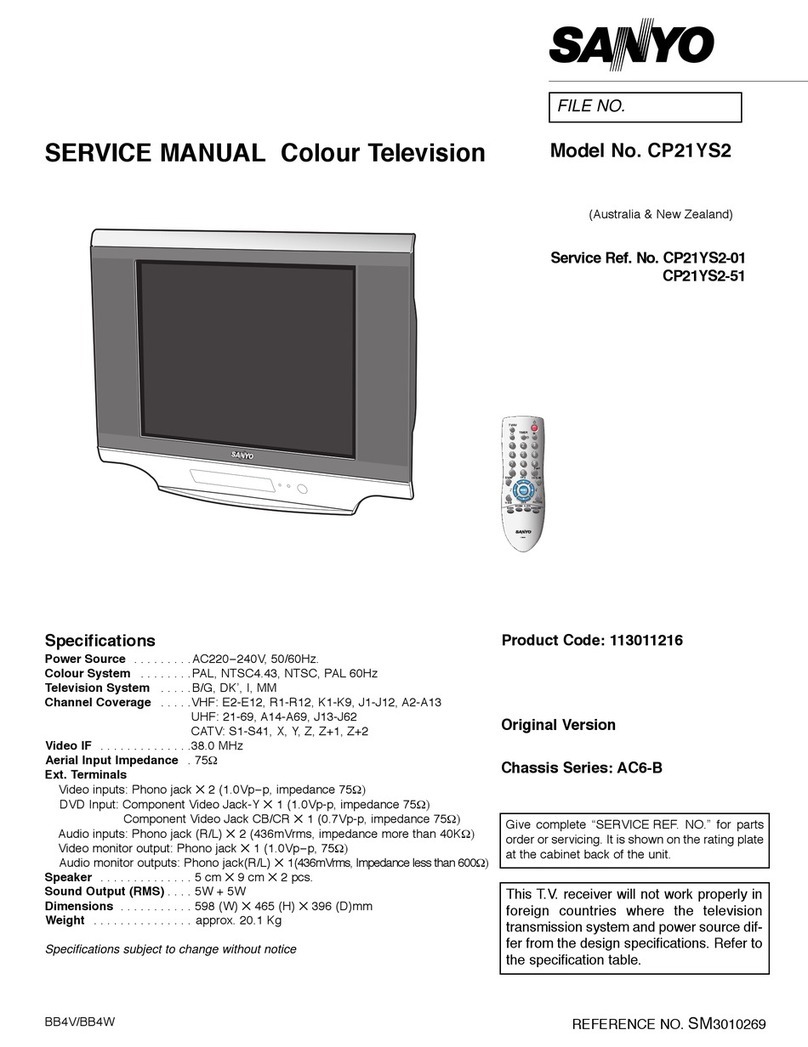
Sanyo
Sanyo CP21YS2 User manual
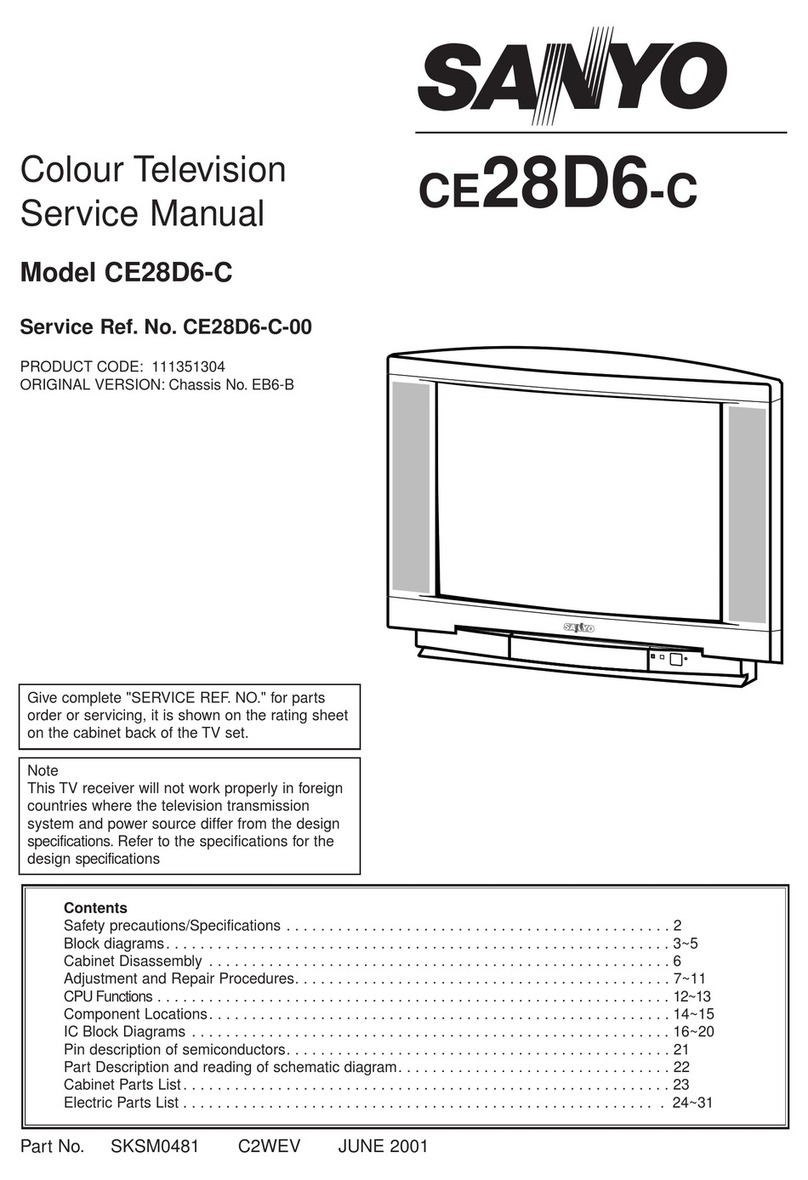
Sanyo
Sanyo CE28D6-C User manual
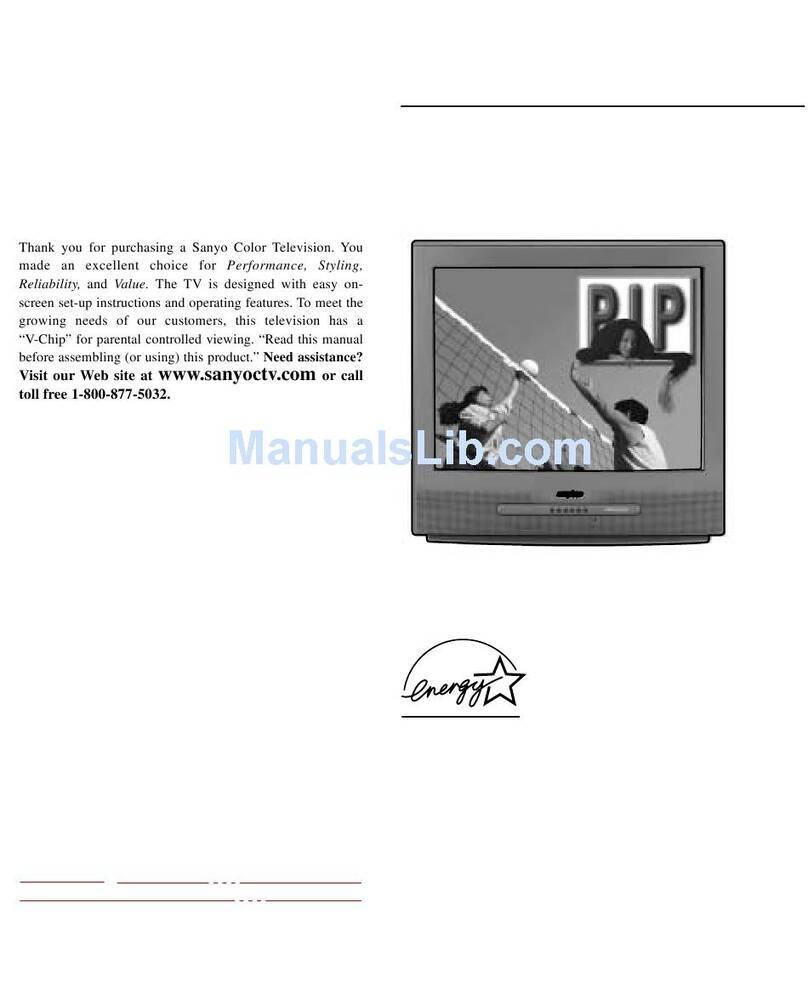
Sanyo
Sanyo DS27820 User manual
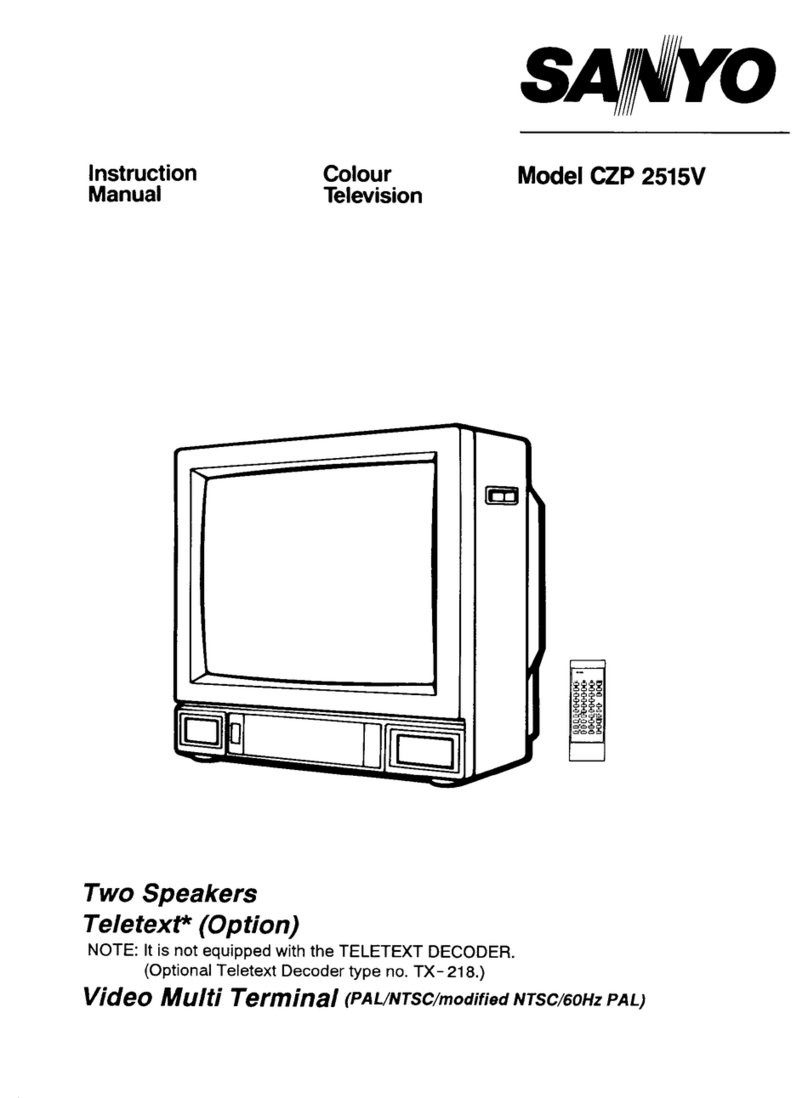
Sanyo
Sanyo CZP2515V User manual
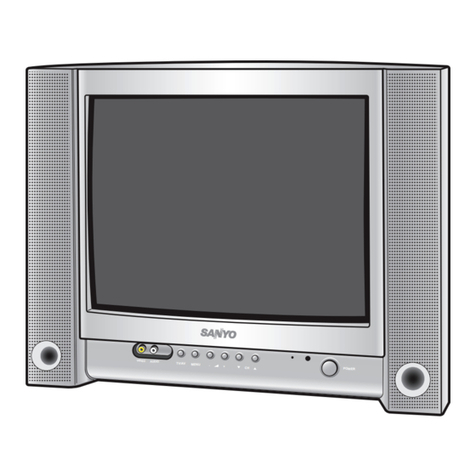
Sanyo
Sanyo CP14CE1 User manual
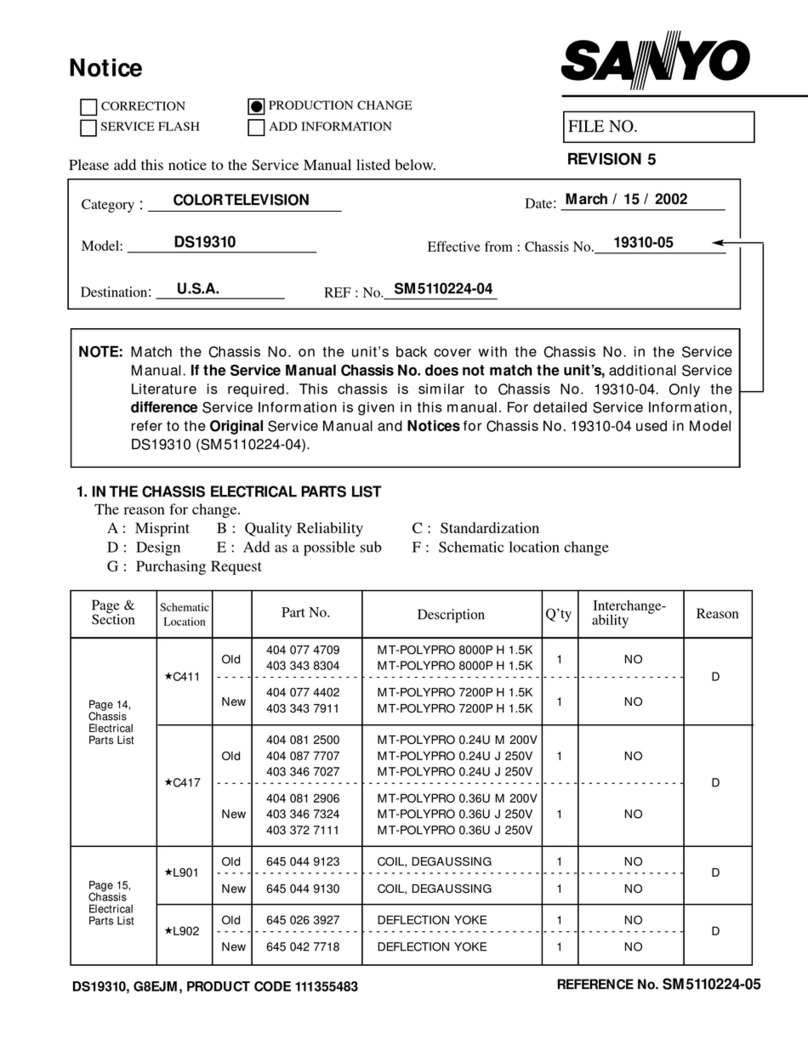
Sanyo
Sanyo DS19310 User manual
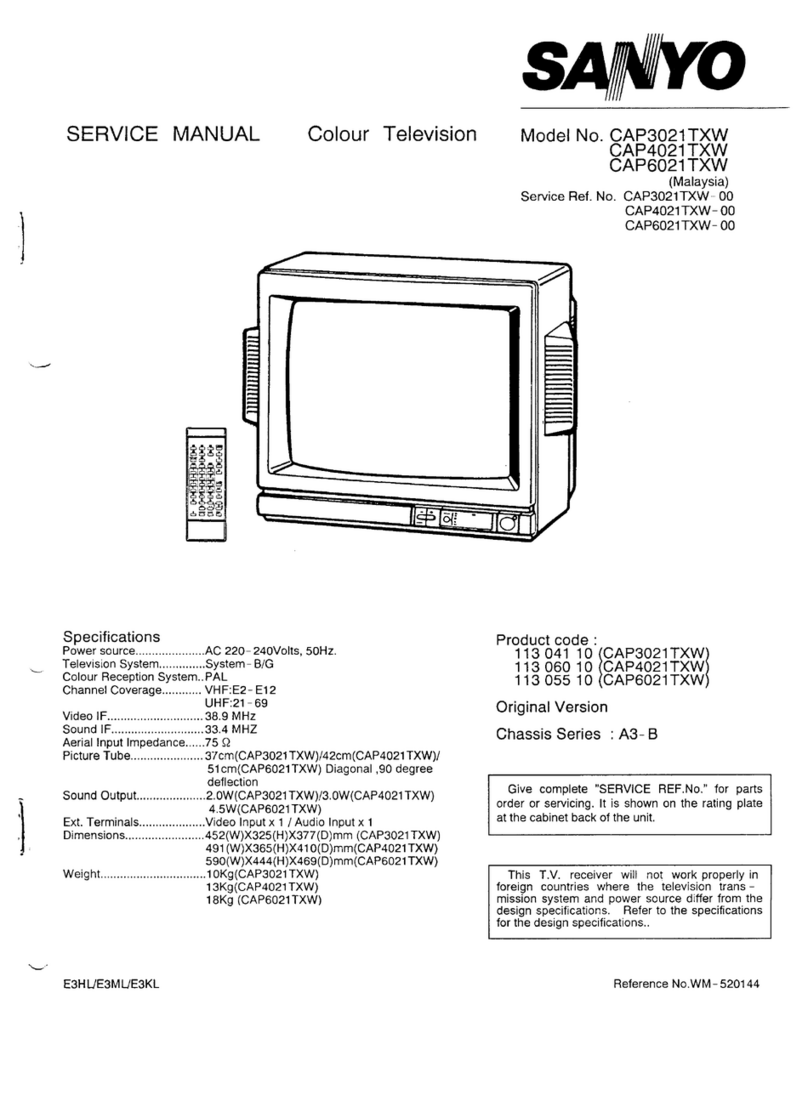
Sanyo
Sanyo CAP3021TXW User manual
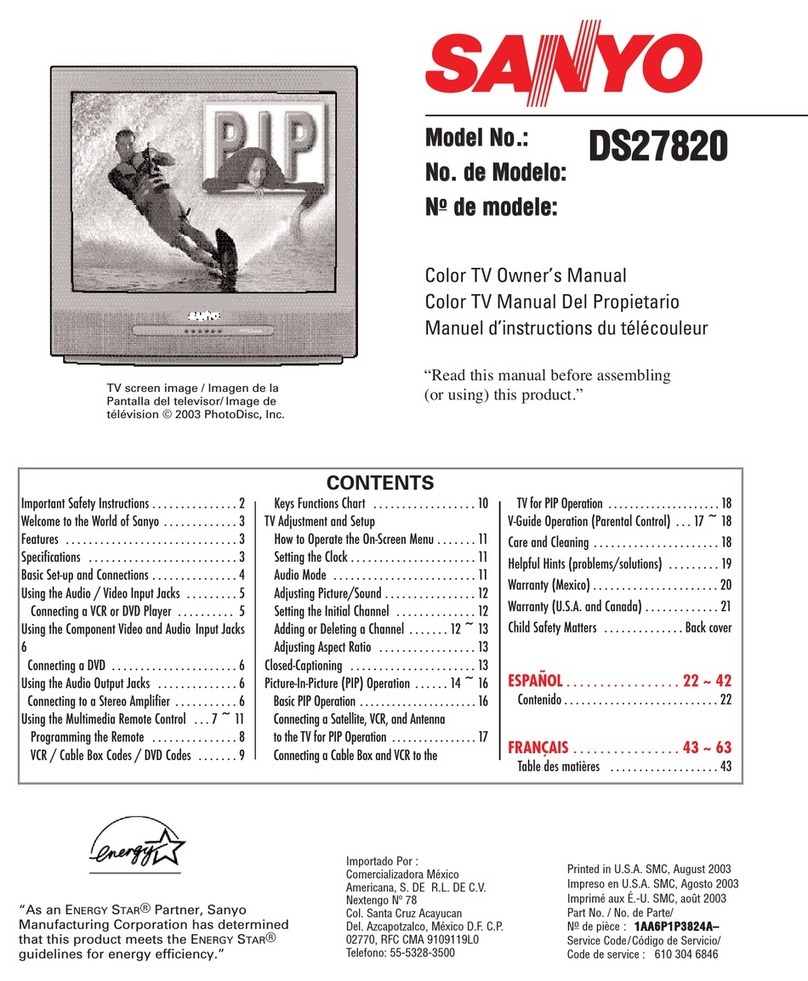
Sanyo
Sanyo DS27820 User manual
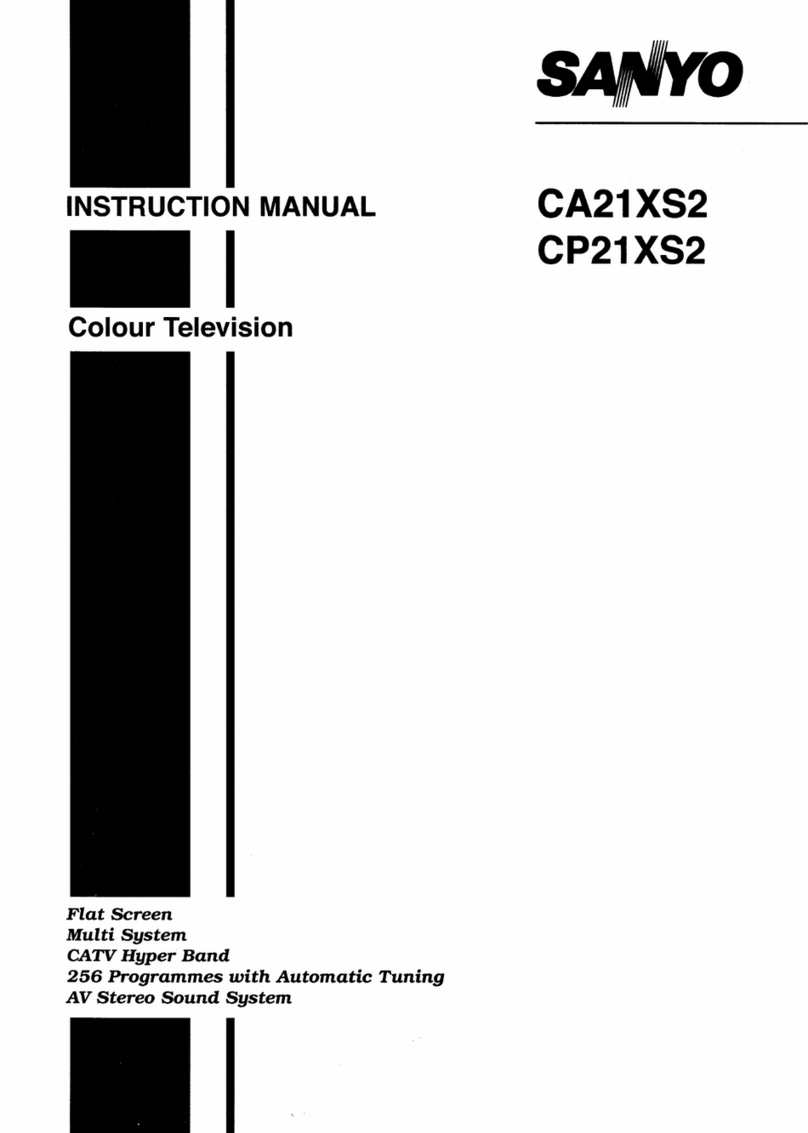
Sanyo
Sanyo CA21XS2 User manual

Sanyo
Sanyo DS27930, DS32424 User manual
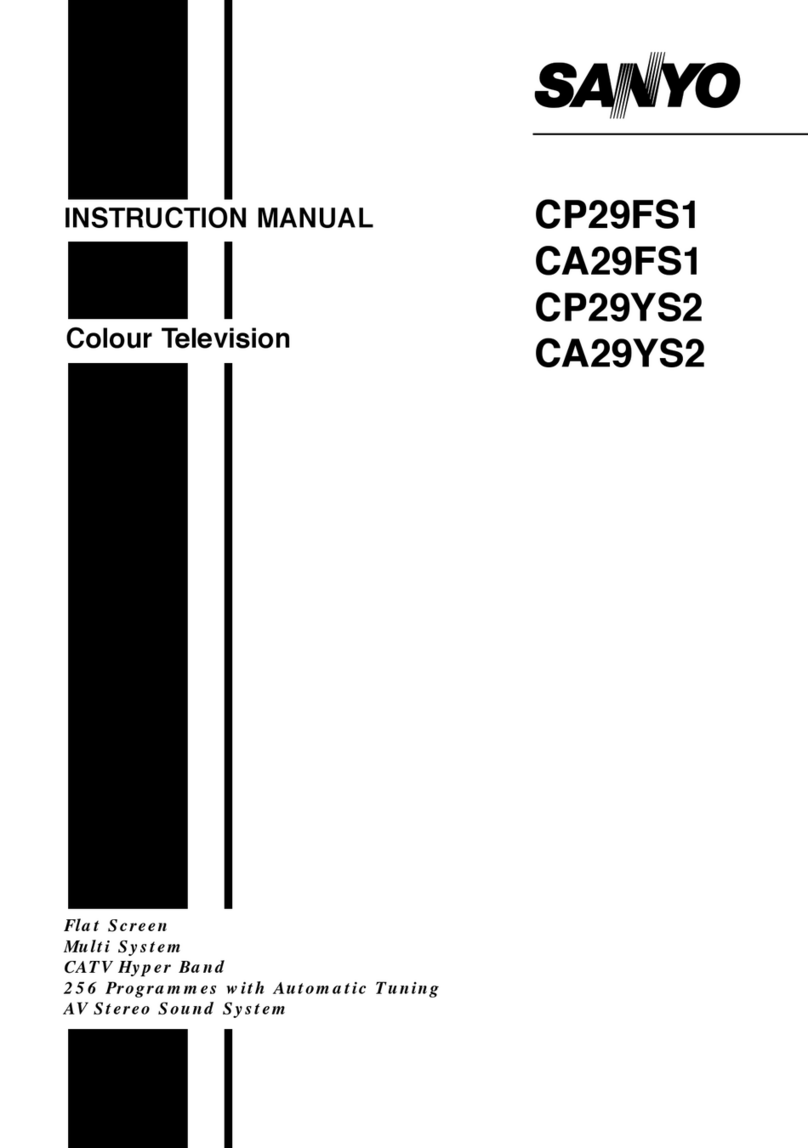
Sanyo
Sanyo CP29FS1 User manual

Sanyo
Sanyo CZP3359TX User manual
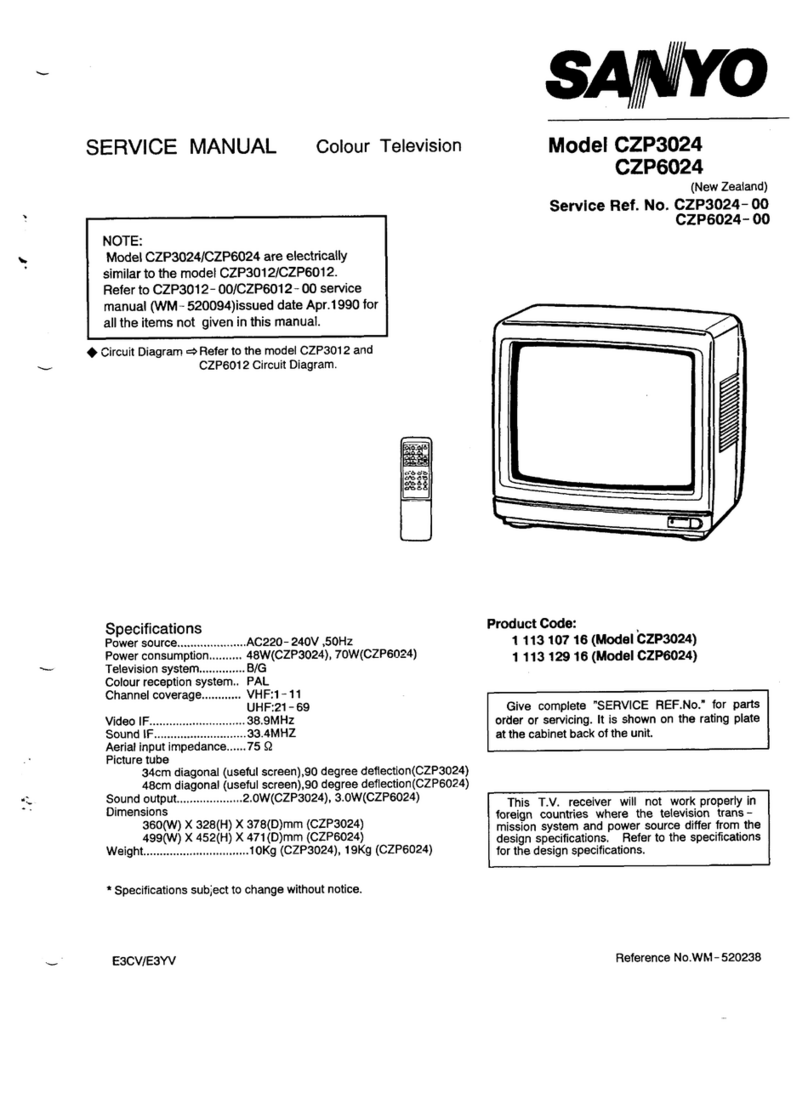
Sanyo
Sanyo CZP3024 User manual
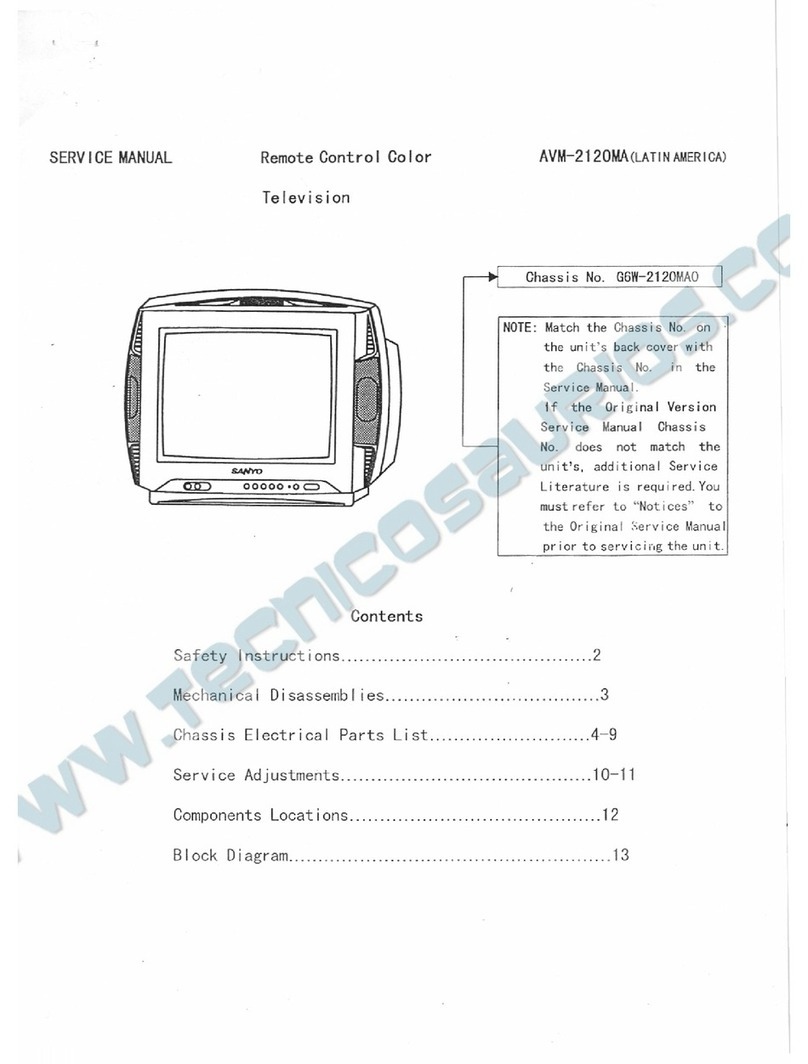
Sanyo
Sanyo AVM-2120MA User manual
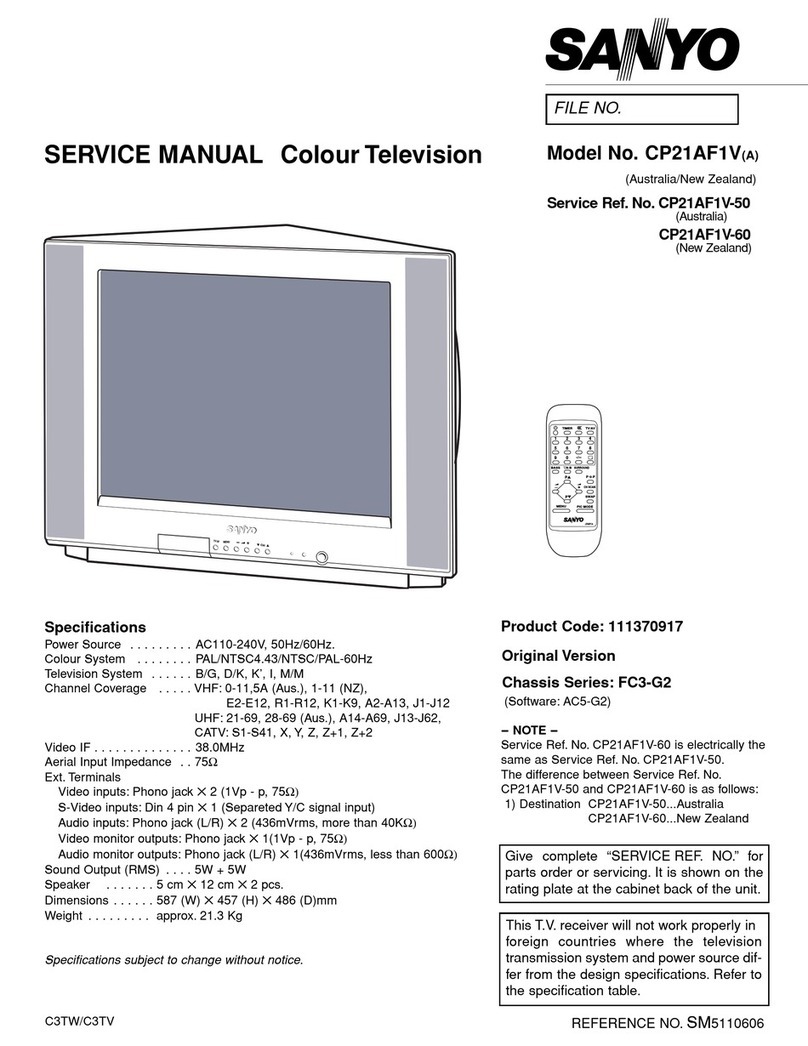
Sanyo
Sanyo CP21AF1VA User manual
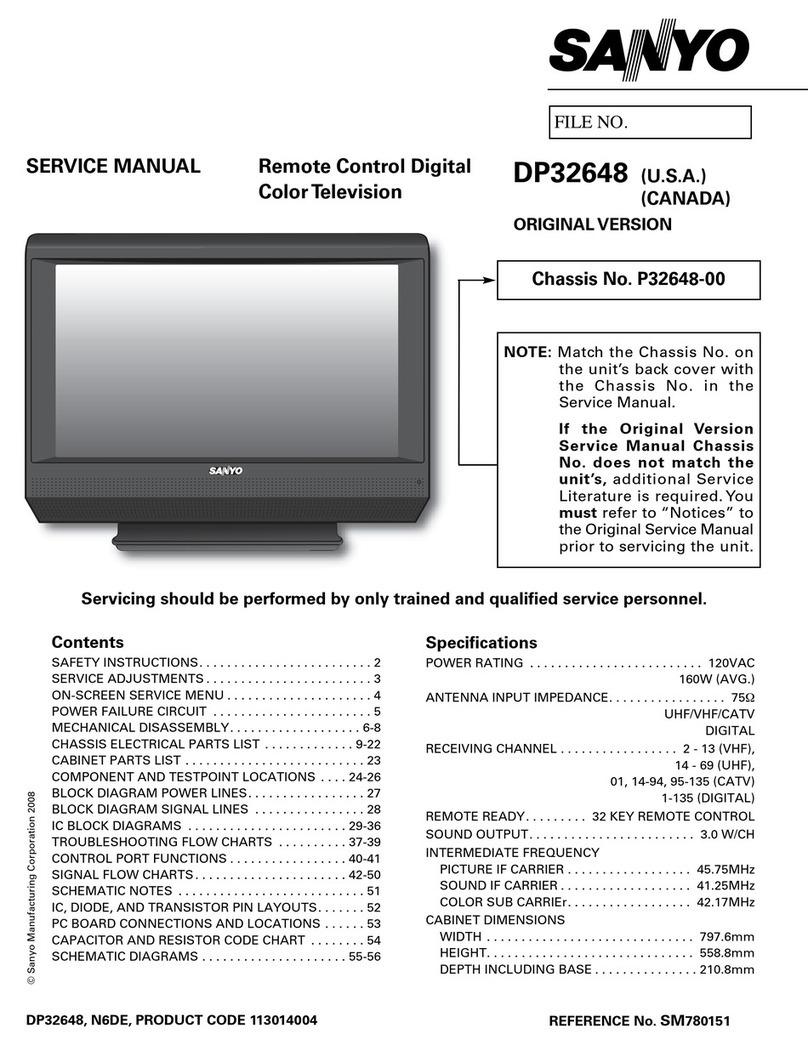
Sanyo
Sanyo DP32648 - 31.5" LCD TV User manual
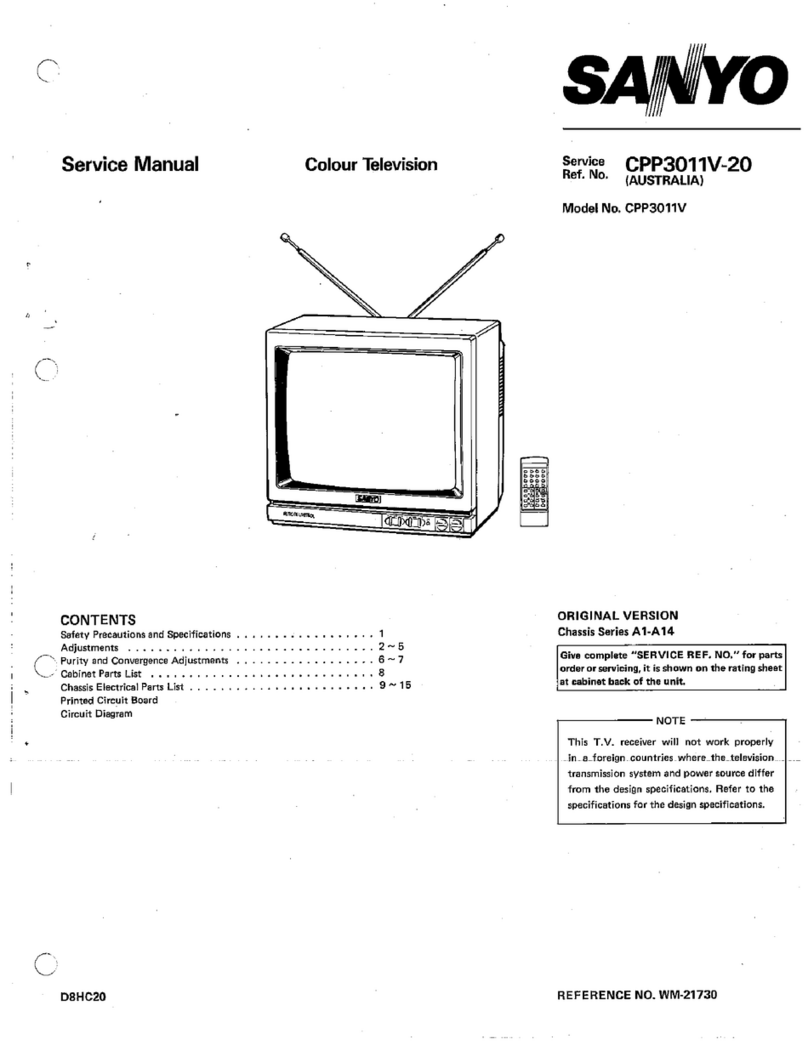
Sanyo
Sanyo CPP3011V User manual
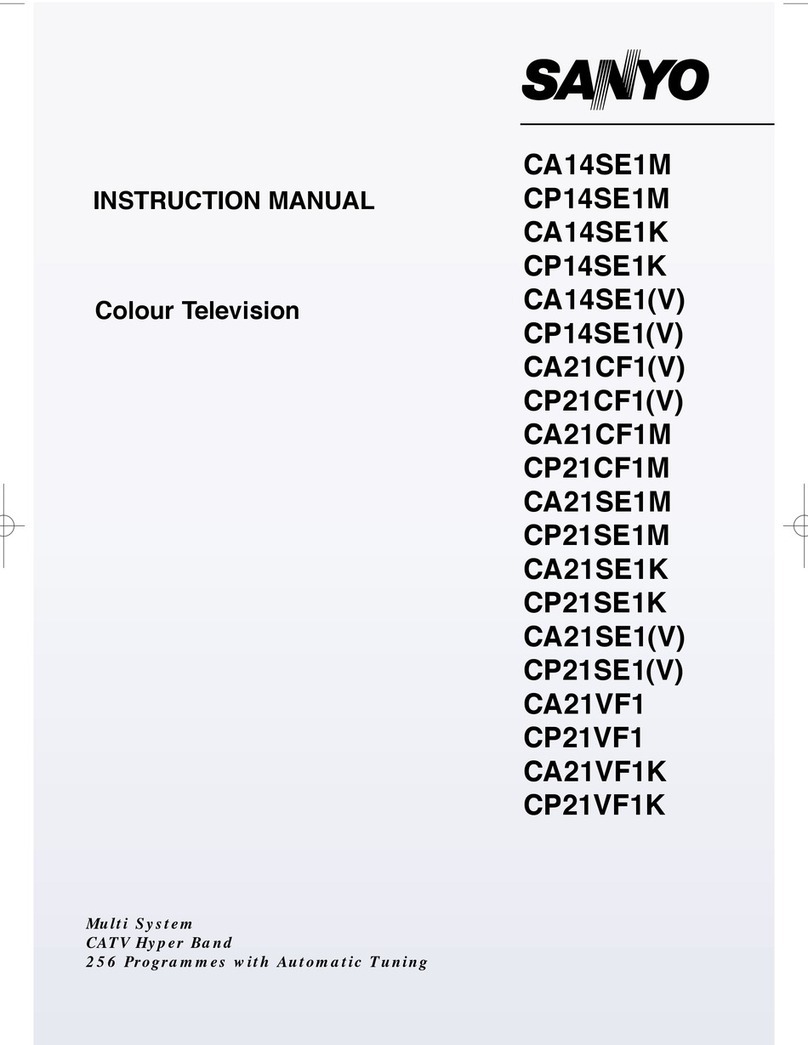
Sanyo
Sanyo 21VF1K User manual
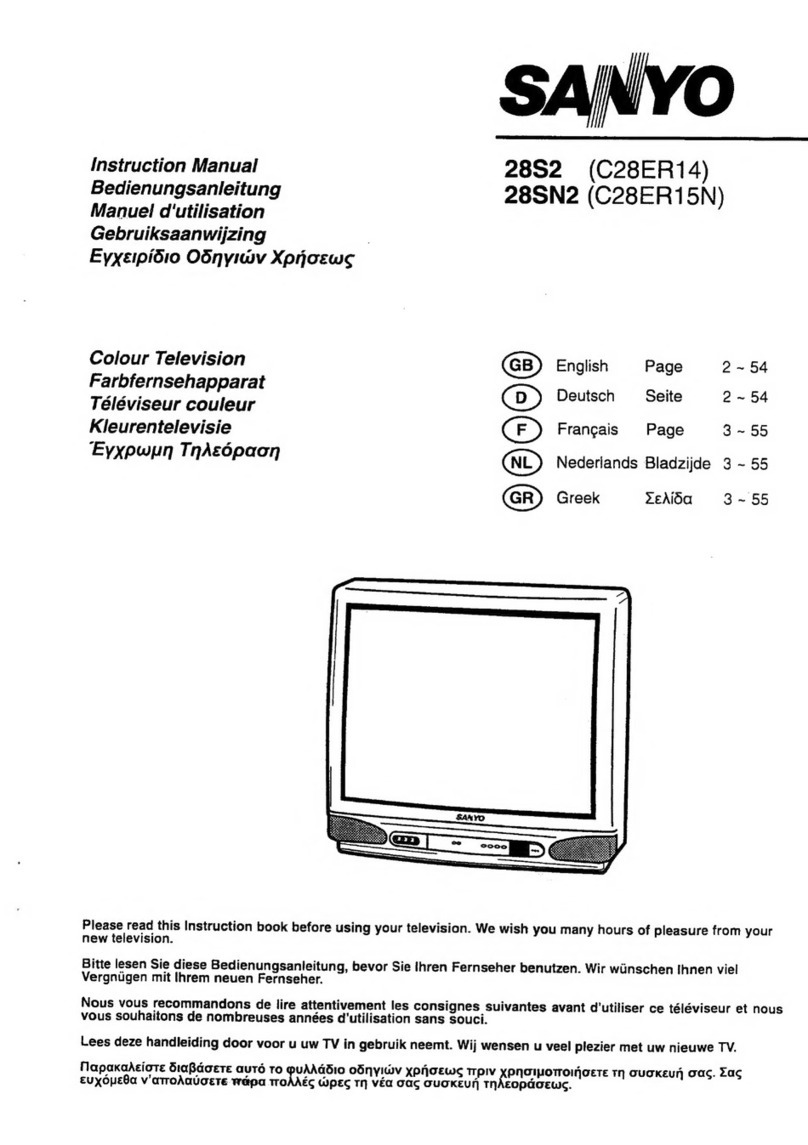
Sanyo
Sanyo 28S2 User manual
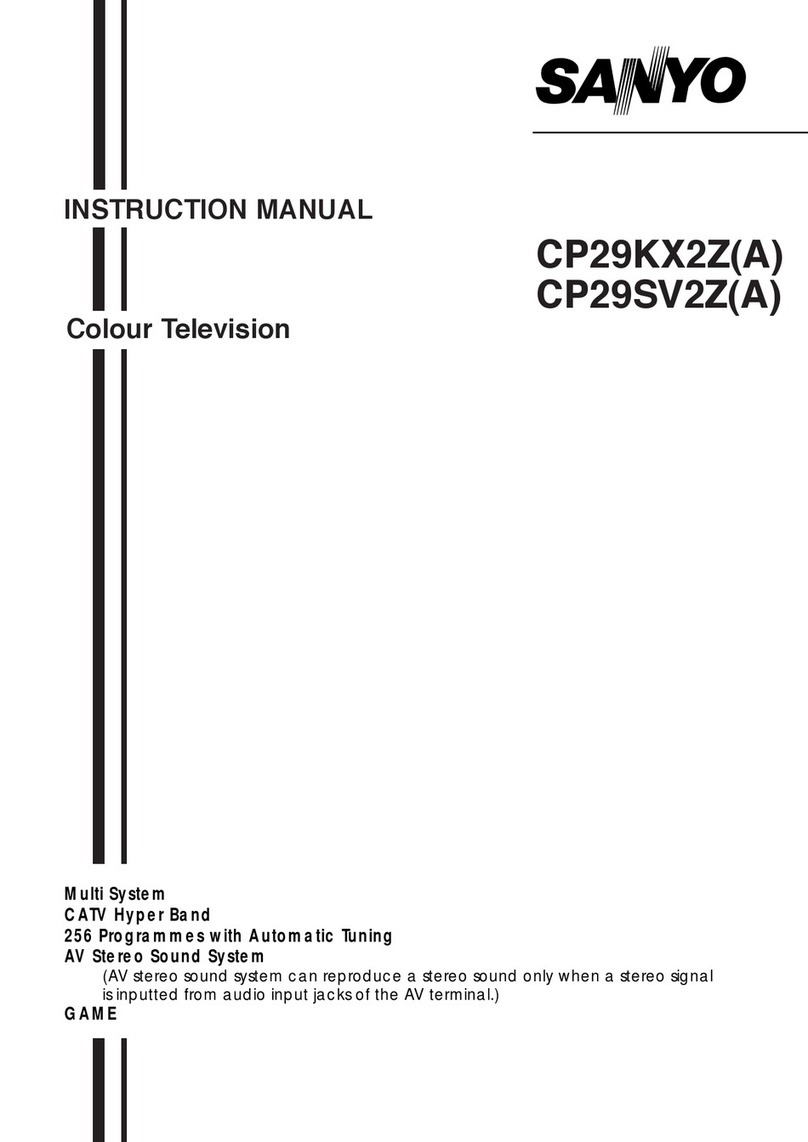
Sanyo
Sanyo CP29KX2Z User manual
